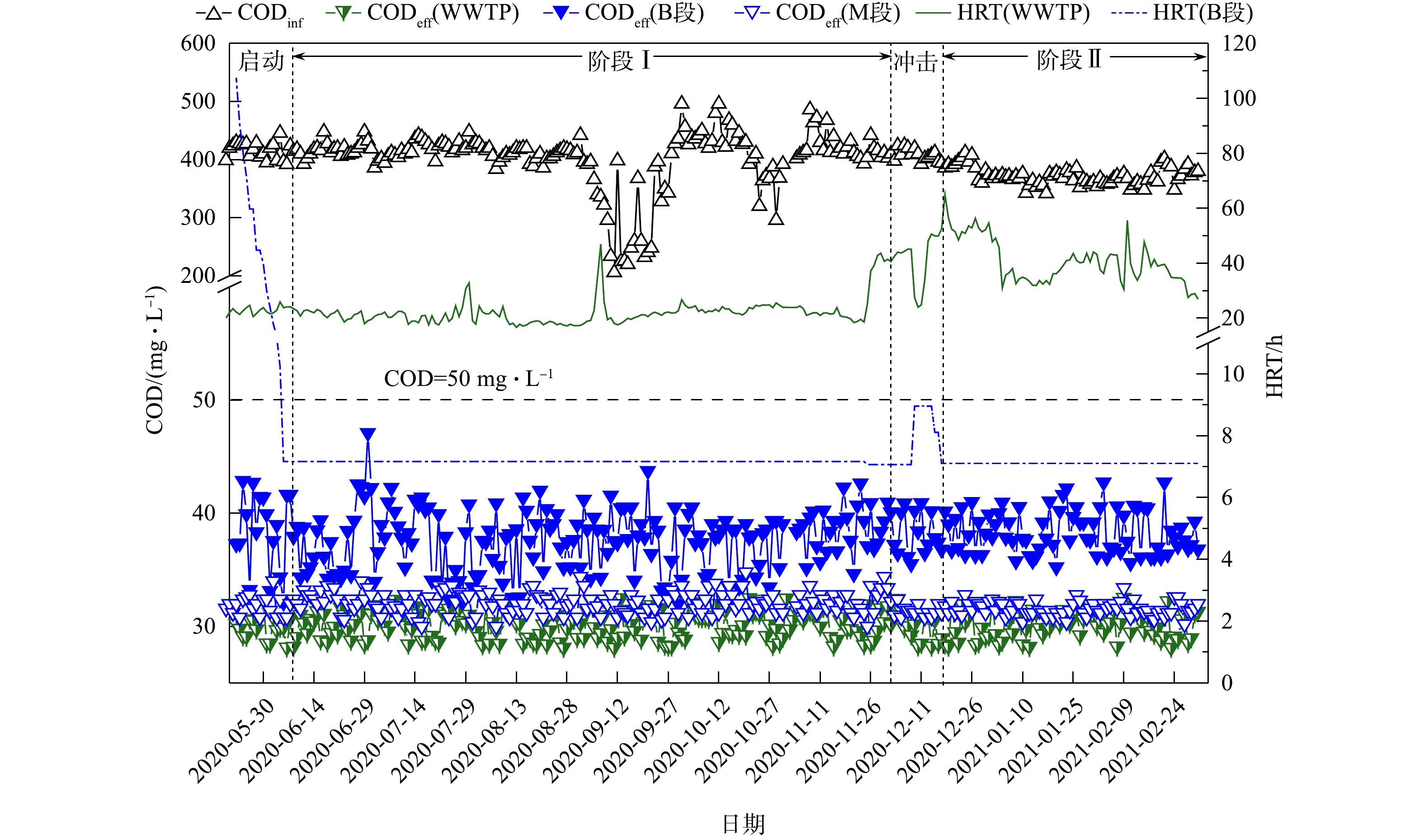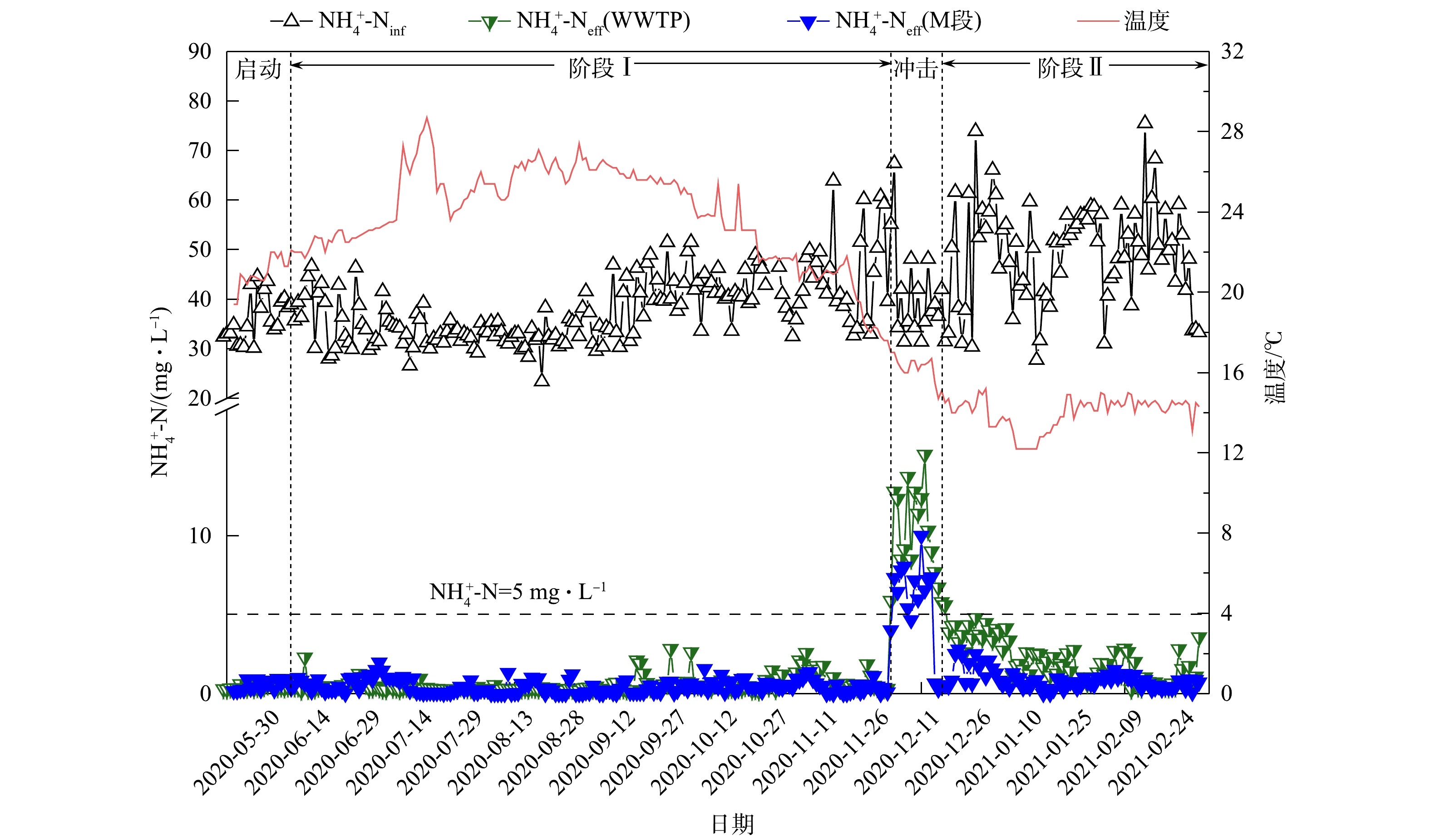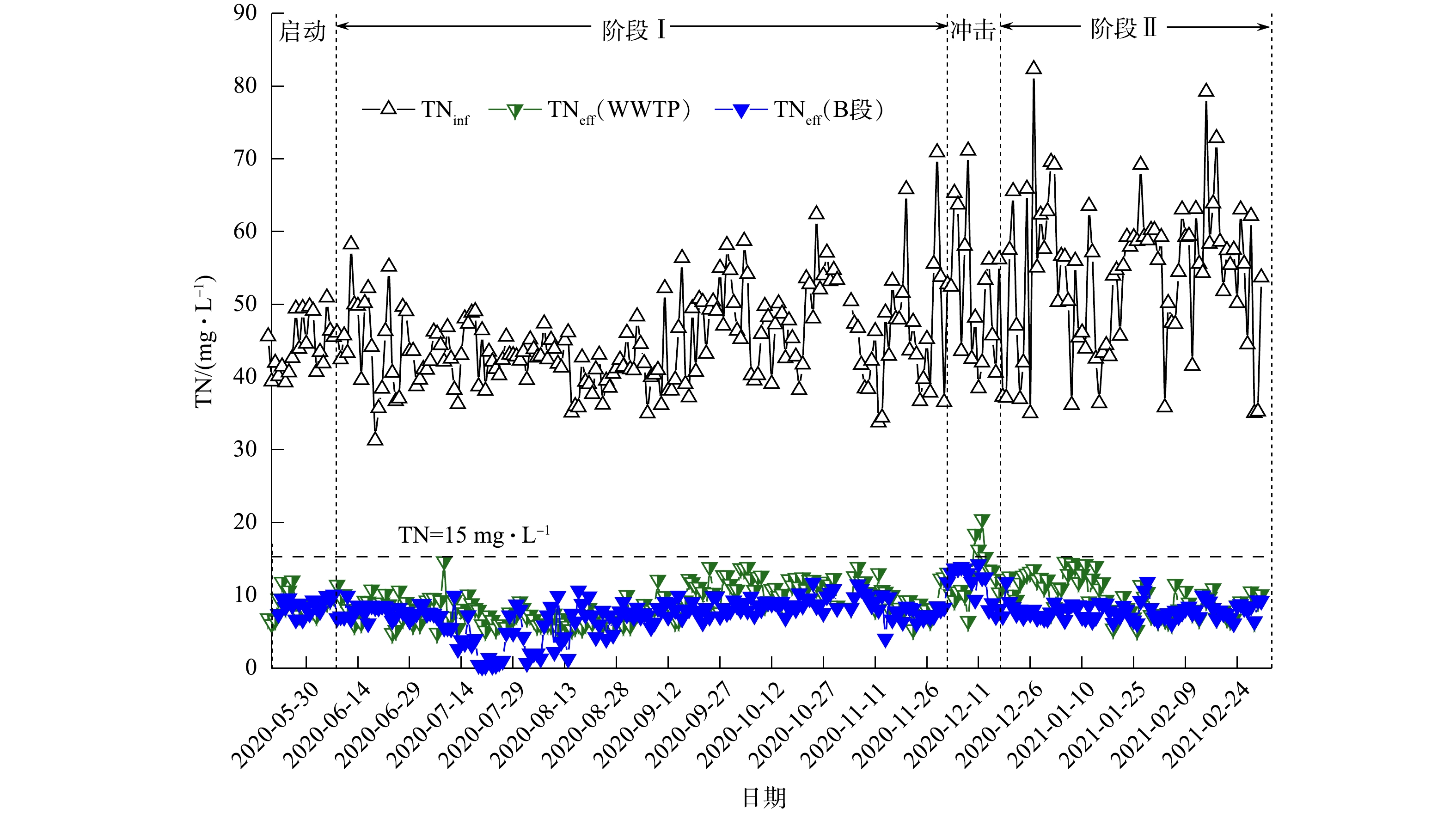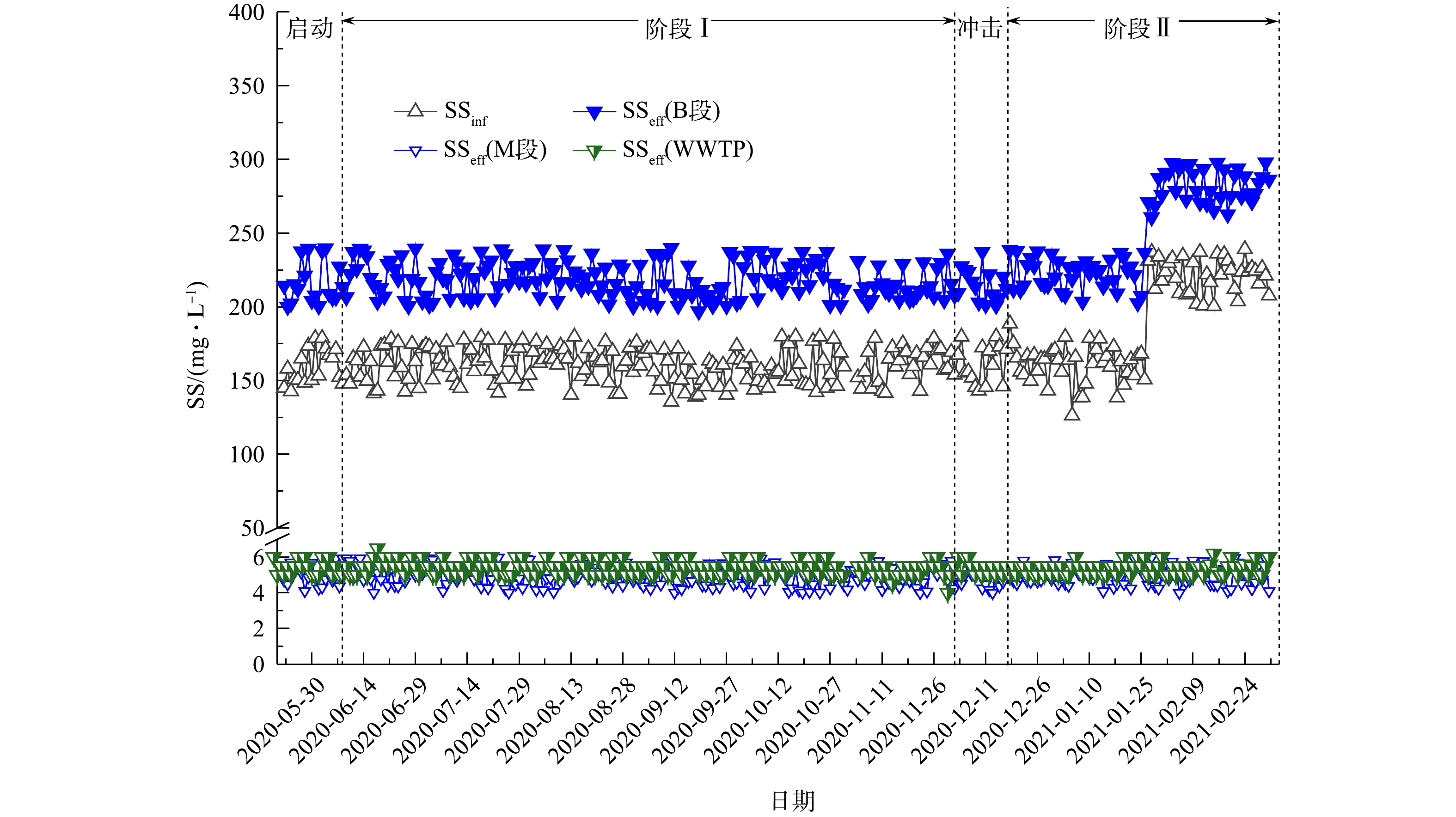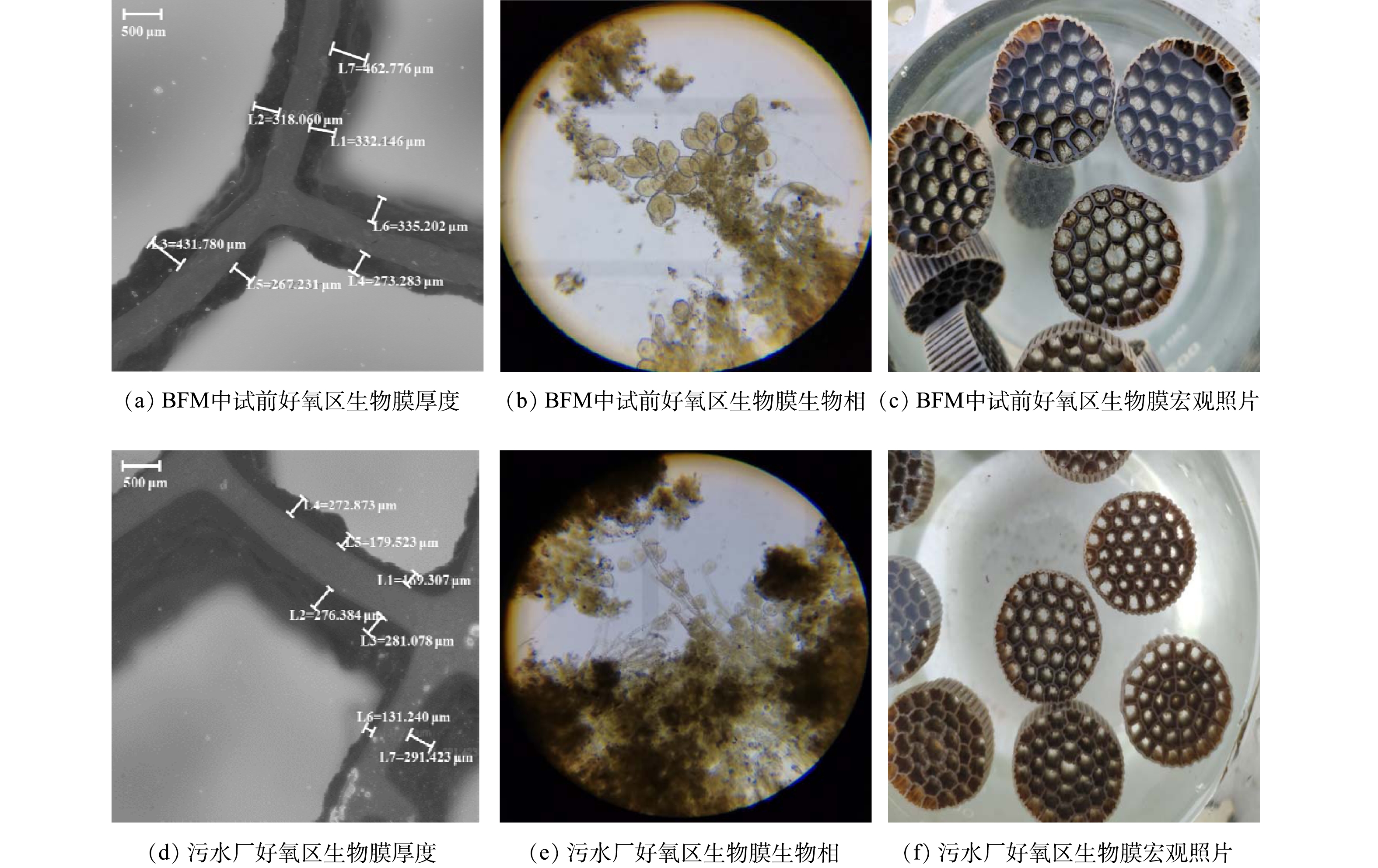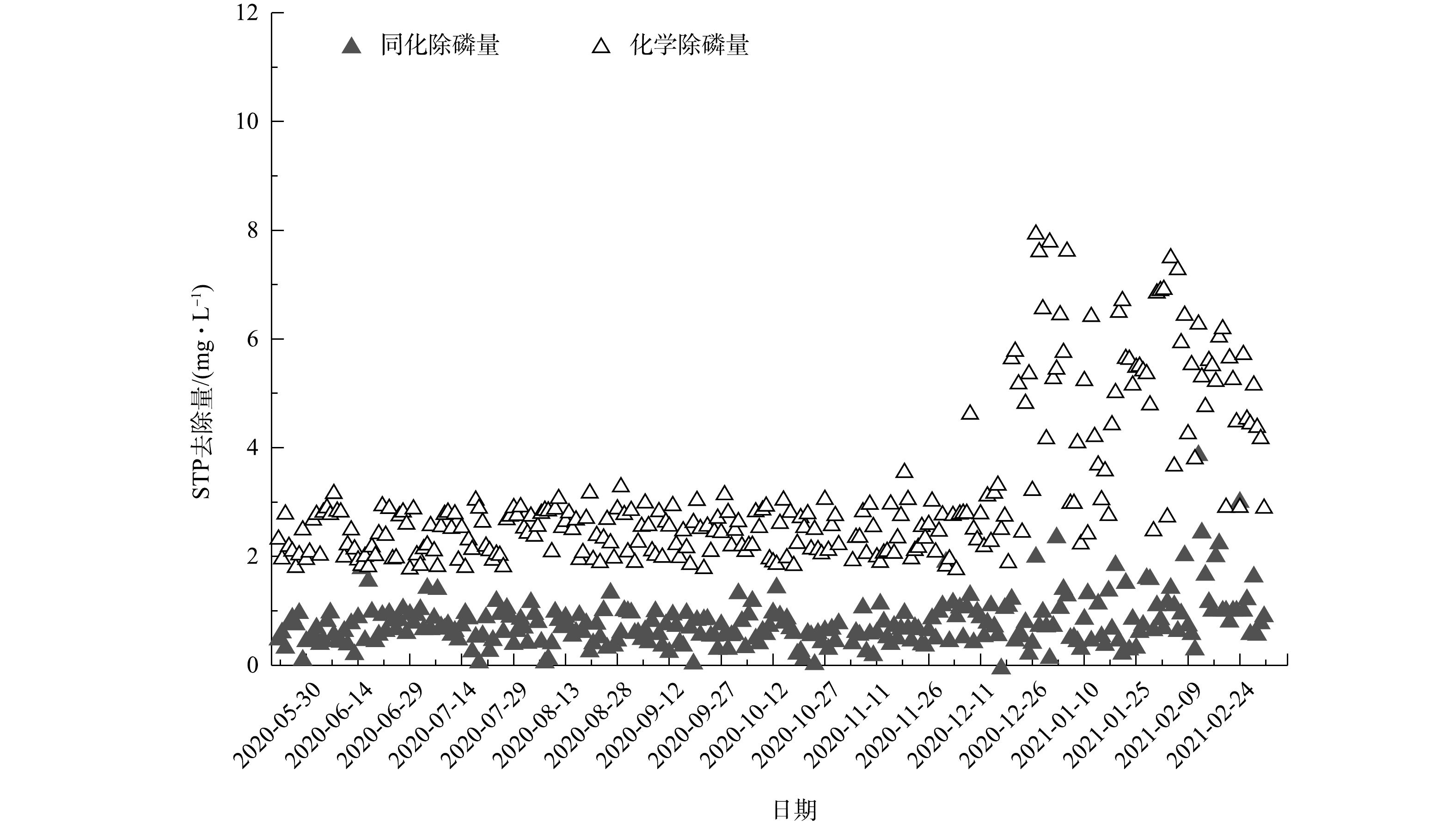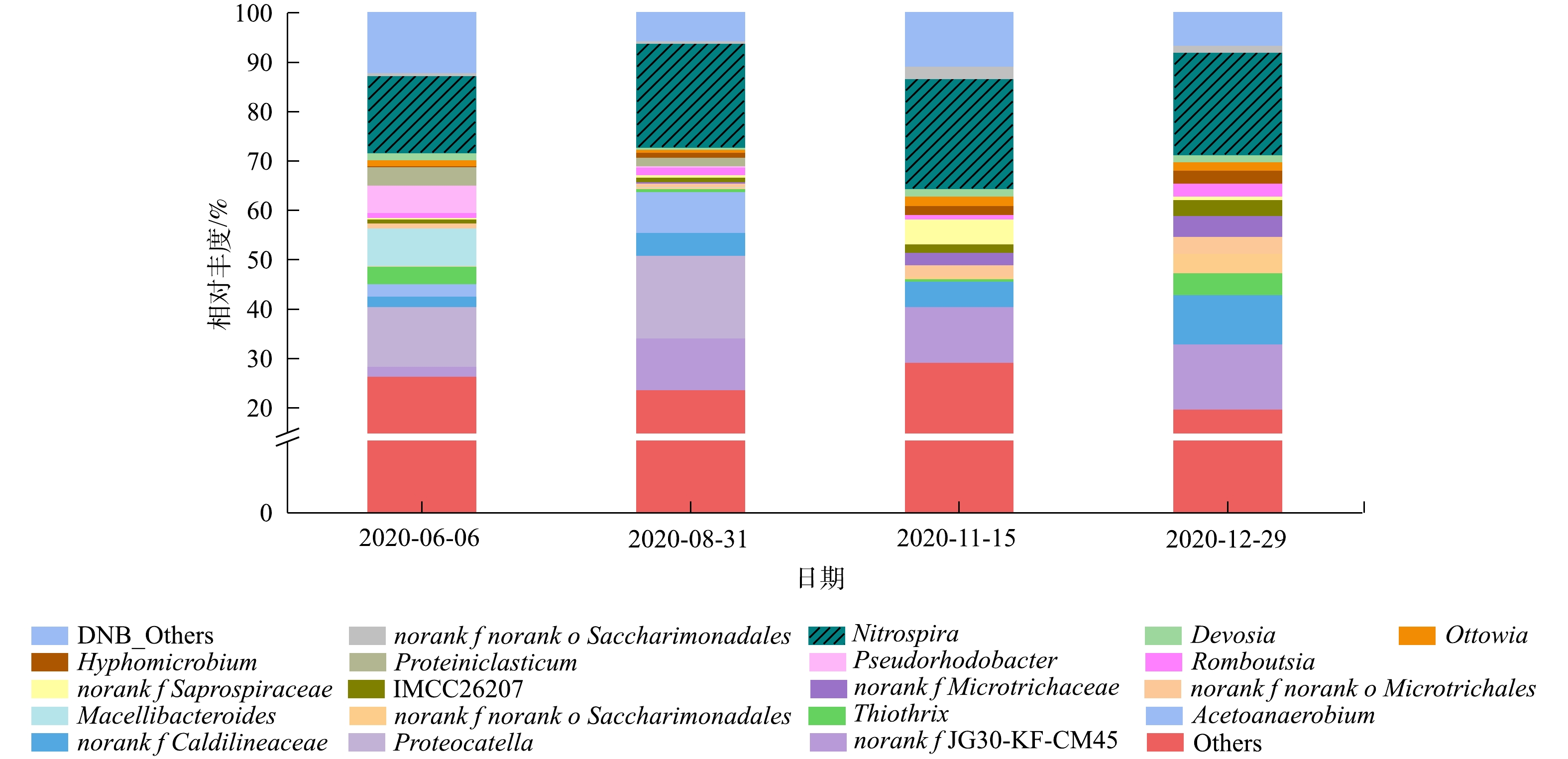-
移动床生物膜反应器(MBBR)根据微生物附着形态,主要分为泥膜复合MBBR工艺和纯膜MBBR工艺两种形式。泥膜复合MBBR系统中,微生物既包含悬浮态活性污泥,也包含附着态生物膜,实际工程中活性污泥为主体,生物膜作为其补充,主要特征仍与活性污泥法相近;在纯膜MBBR系统中,微生物主要以附着态生物膜形式存在,系统不富集活性污泥,不设置污泥回流,属于不需要反冲洗的连续流生物膜法。在国内污水处理厂提标改造的大环境下,泥膜复合MBBR形式由于可以将悬浮载体系统生化段原池镶嵌,且改造灵活、处理效果稳定,故发展迅速,该工艺自2008年在无锡芦村成功应用以来,目前应用规模已超过2 000 万t·d−1。相对而言,纯膜MBBR形式近5 a才在国内逐步得到推广应用,主要用于微污染水[1]、工业水处理中[2]。MBBR工艺诞生之初,即是纯膜MBBR工艺形式,在20世纪90年代,在北欧地区得到广泛应用。挪威利勒哈默尔市的Lillehammer污水处理厂,采用多级AO纯膜MBBR工艺处理市政污水,可实现出水TN<3 mg·L−1,HRT仅为3.2 h;挪威奥斯陆机场的Gardermoen污水处理厂采用多级AO纯膜MBBR工艺,在冬季水温为6~7 ℃条件下,出水NH4+-N和TN分别仅为0.26 mg·L−1和2.16 mg·L−1;菲律宾Petroleum Borger污水处理厂采用纯膜MBBR进行升级改造,改造后出水TN由1~9 mg·L−1降至稳定低于1 mg·L−1[3]。相比泥膜复合MBBR工艺,纯膜MBBR工艺处理负荷更高,系统具有更低的水力停留时间和出水污染物浓度,在节省占地和处理效果上更具有优势。随着污水处理厂新改扩建对于缩减占地的诉求越来越高,紧凑型污水处理工艺的应用前景愈发广阔。目前市场上应用较多的紧凑型污水处理工艺虽能实现污水处理缩减占地的需求,但也存在较大缺陷,如MBR工艺运行能耗过高,且定期换膜也增加了运维成本;BAF工艺对进水SS要求过高,但严格的预处理导致的碳源损失也增加了其脱氮所需外投碳源量,提高了工艺运行成本。纯膜MBBR工艺是解决紧凑型污水处理工艺能耗、药耗高的可能途径之一。2020年,以纯膜MBBR工艺为核心的市政污水处理项目在广东肇庆实现了落地。该项目采用基于纯膜MBBR与改良磁加载沉淀的BFM技术。其中纯膜MBBR段主要去除氮素及有机物,出水进入改良磁加载沉淀工艺段,进行SS、TP和剩余有机物的去除,且磁加载沉淀针对脱落生物膜的理化特性进行工艺改良,泥水分离效率更高。实际运行结果显示,BFM工艺在实现污水的集约化处理的同时,也降低了运行能耗[4]。我国南北方污水水质差异较大,北方水质浓度可达南方的数倍以上,BFM工艺在南方实现了工程应用并取得了良好效果,但对于北方污染物浓度偏高的市政污水水质的应用,目前尚未有报道。本研究以北方某污水厂基于纯膜MBBR的BFM中试为依托,考察了BFM工艺对北方中高浓度市政污水的处理效果;对比了BFM中试和泥膜复合MBBR工艺污水处理厂的处理效果以及BFM工艺的节地效果;为完善工艺设计标准,研究了BFM中试中污染物转化关系;为确定其处理效果的内在机理,进行了生物膜厚度及微生物群落组成研究,以期为污水厂纯膜MBBR及BFM技术的应用提供基础数据。
-
BFM中试采用山东某污水处理厂曝气沉砂池出水。该污水处理厂总处理能力为12 ×104 t·d−1,出水水质执行《城镇污水处理厂污染物排放标准》(GB 18918-2002)一级A标准,工艺流程如图1所示。该污水处理厂生化主体采用A2/O+MBBR工艺,生化池设计总HRT为16.2 h,其中厌氧区和缺氧区HRT 为8.25 h,好氧区HRT为7.95 h,生化系统内外回流比分别为100%~300%和70%~100%,好氧区投加SPR-III型悬浮载体。悬浮载体材质为高密度聚乙烯(HDPE),直径为(25±0.5) mm,高(10±1) mm,有效比表面积大于800 m2·m−3,符合《水处理用高密度聚乙烯悬浮载体》(CJ/T461-2014)行业标准。该污水处理厂深度处理系统为高效沉淀池+V型滤池,以保证出水TP和SS等指标稳定达标,污水处理厂进水COD、NH4+-N、TN、TP、SS分别为(396.56±43.51)、(40.89±9.36)、(47.49±8.56)、(4.78±1.62)、(231.09±40.93) mg·L−1。
-
BFM中试由纯膜MBBR反应器(以下简称B段)和改良磁加载沉淀反应器(以下简称M段)串联组成,BFM中试工艺流程如图2所示,中试装置如图3所示。中试系统各功能段设计参数如表1所示。BFM-B段和BFM-M段有效池容分别为21.50 m3和0.69 m3。BFM-B段设计水量为72.03 m3·d−1,设计停留时间为7.07 h,采用两级A/O形式,各功能区均投加与污水厂相同的SPR-III型悬浮载体。前A/O设置硝化液回流,后缺氧池设置碳源投加系统,采用工业级乙酸钠作为碳源。BFM-B段出水中部分进入BFM-M段,该段设计水量为24.00 m3·d−1,停留时间为0.69 h。M段依次划分为缓冲池、混合池、磁加载池、絮凝池、沉淀池。进水经缓冲池进入到混合池,与混凝剂充分混合,混合池出水进入磁加载池,通过磁种投加形成磁絮体,磁加载池出水进入到絮凝池,增大絮体粒径,提高絮体沉降速率,絮凝池出水进入到沉淀池进行泥水分离,上清液排出系统,底部污泥一部分作为磁种回流到磁加载池,另一部分经过高剪机和磁分离机分离并回收磁种,分离出的磁种回流到磁加载池,污泥则作为剩余污泥排出系统。高梯度磁分离机核心磁感应强度≥6 000 Gs (600 mT),磁种回收率达到99.5%以上,混合池和絮凝池分别连续投加PAFC(Al2O3含量为31%)和PAM,其中PAFC投加量根据进水溶解性总磷(STP)浓度调整,PAM投加量控制在0.5 mg·L−1左右。
-
BFM中试运行过程划分为4个阶段,如表2所示。启动阶段,系统投加未挂膜的悬浮载体,长HRT逐步培养载体挂膜,逐步降低HRT运行至设计值;阶段I为系统稳定运行阶段,该阶段固定HRT,主要处于夏秋,关注温度逐步降低对系统处理效果的影响;重金属冲击阶段,进水中重金属超标导致系统处理效果受到抑制,并进行了恢复;阶段II为系统处理效果恢复后,再次稳定运行,该阶段主要处于冬季,分析低温的运行效果。
-
为研究BFM中试系统各功能段基质转化情况,分别取系统进水、BFM-B段出水、BFM-M段出水,分别测定水质的COD、SS及TP等参数。在进行TP去除途径分析时,生化段同化除磷率m按照式(1)进行核算,因纯膜MBBR段SS污泥转化率近似为1,因此,计算时仅考虑SCOD及STP的同化去除。
式中:m为除磷率;P1、P2分别为进水及生化段出水溶解性TP浓度,mg·L−1;C1、C21、C4分别为总进水COD、生化段出水及生化段外投溶解性COD,mg·L−1。
-
研究过程中,于每个运行阶段采集BFM中试系统前AO段好氧区悬浮载体样品和污水厂好氧区悬浮载体及活性污泥样品,经预处理后进行基于16Sr DNA的扩增子高通量测序。测序选用试剂盒(E.Z.N.A Mag-Bind Soil DNA Kit,OMEGA) 提取微生物基因组DNA,通过1%琼脂糖凝胶电泳检测抽提基因组的完整性,利用Qubit3.0 DNA试剂盒测定基因组DNA浓度。PCR 扩增所用引物为341F/805R。对PCR产物进行琼脂糖凝胶电泳,并通过DNA 胶回收试剂盒(SanPrep)对PCR产物进行回收,利用Qubit3.0 DNA检测试剂盒对回收的DNA 精确定量,按照1∶1的等量混合后测序;通过Illumina Miseq 测序平台完成对样品的高通量测序。测序结果中有关α多样性及物种组成参考已有方法进行分析。
-
COD采用重铬酸钾法测定;NH4+-N采用纳氏试剂分光光度法测定;TN采用紫外分光光度法测定;TP采用钼锑抗分光光度法;SS采用称重法测定;重金属通过第三方机构检测,镉、铅、铬、铜及锌均采用ICP-AES法测定,结果均为3次样品测定后的平均值;DO采用 WTW Multi-3430i 测定。水质测定取样点分别为污水厂进水、BFM-B段出水、BFM-M段出水及污水厂二沉池出水,其中仅污水厂进水在测定COD时取混合样,其余指标及其他取样点所有指标均过滤后检测。悬浮载体生物膜生物量、悬浮载体生物膜挥发性成分占比测定时取各功能段悬浮载体,参考已有文献进行测定[5],并以均值计。于2020年11月20日取BFM中试B段和污水厂好氧区生物膜进行厚度测定,在工业显微镜(奥斯微,AO-HD228SD)下带水条件下测定。
-
BFM中试系统由B段和M段2部分组成,其中B段主要去除NH4+-N和TN,同时去除大部分COD;而M段则进一步去除COD、SS和TP,处理效果如图4~8所示。启动阶段系统未接种活性污泥,采用自然挂膜方式,以出水NH4+-N为主要控制指标,逐步提升进水流量和曝气量。运行至17 d,B段HRT由107.52 h逐渐降至7.07 h时,出水COD、NH4+-N和TN能够稳定达标,B段达到设计HRT,标志启动成功。系统自2020年6月7日开始进入稳定运行状态,虽中间经历了重金属冲击阶段,但仅经过16 d即可快速恢复,随后BFM中试系统进入低温运行状态。整个运行过程中,在稳定运行阶段,系统运行的气水比为6.1±0.7,相比污水处理厂差异不大,核算曝气能耗约为0.33 kWh·t−1,折合电费约为0.20 元·m−3。
在运行阶段Ⅰ,进水COD为(401.29±52.51) mg·L−1,B段出水COD为(37.66±2.72) mg·L−1,略高于污水处理厂出水COD的(32.11±0.96) mg·L−1,平均高出5.55 mg·L−1,约占17.1%,但B段HRT仅为7.07 h,是对照污水处理厂实际运行HRT(22 h)的32.6 %。BFM中试B段出水COD略高,存在以下2种可能:一方面可能是HRT大幅度缩短,出现了COD的穿透现象;另一方面,可能由于脱落生物膜引起胶体类COD的升高,而B段的生物絮凝作用较活性污泥法弱,造成COD偏高。为验证猜测,取B段出水上清液,加入好氧区挂膜悬浮载体,进行延时曝气,发现COD能够由(37.93±2.55) mg·L−1降至(35.62±2.59) mg·L−1;另外,B段出水经后端M段处理后,出水COD进一步降至(31.88±0.59) mg·L−1,与污水处理厂出水相当,即通过混凝过程能够进一步降低COD。综上所述,B段COD偏高的2种可能原因同时存在,且后者为主要因素。通过生物膜的生化、磁加载沉淀物化作用的联合推动下,最终BFM的COD处理效果与污水处理厂相当,无显著性差别,能够满足排放标准要求。在运行阶段II,COD变化规律与运行I阶段相同。对于温度变化,BFM中试系统与污水处理厂对COD处理的效果并未体现出显著性差异,说明温度对于纯膜MBBR系统的COD处理效果影响不大。
在运行阶段Ⅰ,进水NH4+-N为(37.93±6.98) mg·L−1,B段出水NH4+-N为(0.44±0.41) mg·L−1,与污水处理厂出水NH4+-N(0.58±0.50) mg·L−1相当,但此时B段HRT不足污水处理厂的1/3,说明B段纯膜MBBR系统的硝化能力明显强于污水处理厂泥膜复合系统。在运行阶段Ⅱ,进水温度由(23.9±2.4) ℃降至(14.0±0.8) ℃,B段出水NH4+-N仍稳定在(0.87±0.60) mg·L−1,这与运行阶段I相当;污水处理厂出水NH4+-N为(2.09±1.40) mg·L−1,明显高于运行Ⅰ阶段,平均高出1.22 mg·L−1,约140.23%。且此阶段污水厂HRT较运行阶段Ⅰ升高幅度近1倍。相比以活性污泥为主体的泥膜复合系统,BFM-B段纯膜MBBR系统的硝化能力具有更强的抗低温性能。
BFM-B段采用两级AO的形式,前AO设置内回流,回流比为200%~250%,后A连续外投碳源乙酸钠,碳源投加量(以BOD计)为(11.63±0.29) mg·L−1,碳源投加费用约0.08 元·m−3,而对照污水处理厂未外投碳源。在运行阶段Ⅰ,进水TN为(44.80±6.32) mg·L−1,B段出水TN为(7.16±2.48) mg·L−1,低于污水厂出水TN的(8.81±2.38) mg·L−1,平均降低了1.65 mg·L−1,约23.04%,B段的脱氮效果略优于污水处理厂。在运行阶段Ⅱ,进水温度由(23.9±2.4) ℃降至(14.0±0.8) ℃,进水TN升至(54.07±10.38) mg·L−1,B段和污水处理厂出水TN较阶段Ⅰ无明显变化。其中,B段出水TN稳定在(7.90±1.17) mg·L−1,污水处理厂出水TN由重金属冲击后的(12.03±1.82) mg·L−1逐渐降至(8.39±1.68) mg·L−1。虽然BFM的TN去除效果略优于污水处理厂,但其在后缺氧区投加了碳源,碳源投加量相当于2~2.5 mg·L−1的去除量,整体上与污水处理厂TN去除效果相当。若将出水TN标准进一步降低至10 mg·L−1时,BFM即已能够稳定实现,而污水处理厂需投加碳源,整体上碳源利用率相当。
在运行阶段Ⅰ,进水SS为(160.09±11.69) mg·L−1,B段出水SS升至(218.51±11.79) mg·L−1,经过M段深度处理后,出水SS进一步降至(4.96±0.56) mg·L−1,与污水处理厂总出水SS(5.40±0.39) mg·L−1差距不大。在运行阶段Ⅱ,进水SS由(160.81±12.91) mg·L−1升至(222.26±11.79) mg·L−1,B段出水也由(222.68±10.33) mg·L−1升至(281.38±11.34) mg·L−1,但M段和污水处理厂出水SS无明显变化,分别为(4.95±0.75) mg·L−1和(5.28±0.65) mg·L−1。BFM中试系统仅有B段和M段,而污水处理厂生化池后,则设置了二沉池、混凝沉淀、过滤,但BFM的SS处理效果略优于污水处理厂,即BFM短流程条件下即可实现对二沉池、深度处理的替代。BFM中,悬浮态污泥浓度低,数值上远低于活性污泥法中的污泥浓度,高于深度处理的进水SS浓度。若采用传统2次沉淀,即二沉池、深度处理混凝沉淀,流程冗长、效率低,且脱落生物膜易聚集上浮,不利于泥水分离。采用磁加载沉淀,利用其高水力负荷特点,实现快速沉降,避免脱落生物膜长期停留聚集上浮。采用磁加载沉淀处理某企业IC出水,在进水SS为(473.48±40.01) mg·L−1的情况下,出水SS降至(7.62±1.08) mg·L−1;后期磁加载沉淀系统进水改为主流二沉池出水,进水SS为(35.38±7.77) mg·L−1,出水SS降为(5.70±1.45) mg·L−1,显示出磁加载沉淀能够适应较大范围的固体通量变化以及其对SS去除的稳定性[6],这也为纯膜MBBR工艺的后处理提供了技术思路。通过纯膜MBBR与磁加载沉淀工艺相结合,形成了短流程、少占地的集约型处理工艺组合。针对脱落生物膜黏性强,磁种不易分离的特性,进一步对关键设备进行改良,形成改良磁加载沉淀与纯膜MBBR工艺耦合,能够实现污水的稳定处理。
运行过程中BFM中试M段PAFC投加量均值为7.65~14.61 mg·L−1(以有效Al2O3计),污水处理厂在二沉池前端PAFC投加量约为7.16~12.20 mg·L−1(以有效Al2O3计)。在运行阶段Ⅰ,进水TP为(4.25±0.48) mg·L−1,经过M段处理后,出水TP降至 (0.13±0.03) mg·L−1,略低于污水处理厂出水TP (0.21±0.08) mg·L−1;在运行阶段Ⅱ,进水TP升至(7.27±1.77) mg·L−1,但M段出水依然能够降至(0.13±0.03) mg·L−1,而污水处理厂出水TP虽然能够降至(0.09±0.04) mg·L−1,但其出水TP波动性较大。
BFM中试系统和污水处理厂均有悬浮载体,但其培养方式不同,表现出一定差异,在运行I阶段取出悬浮载体观察,结果如图9所示。2个系统硝化区悬浮载体挂膜良好,BFM-B段前好氧区和泥布湾污水处理厂好氧区悬浮载体厚度分别为(345.78±74.81) μm和(228.83±66.27) μm,BFM-B段悬浮载体挂膜厚度相对更厚,主要是其承担污染物处理负荷更高,相对生物量更大。在显微镜下可见较多固着缘毛目原生动物,显示该系统处理效果良好。综上所述,采用基于纯膜MBBR与改良磁加载沉淀的BFM中试处理北方中等浓度市政污水,系统总HRT仅为7.76 h,出水指标稳定达到并优于一级A排放标准。BFM仅为2段,利用改良磁加载沉淀,代替活性污泥系统的二沉池、深度处理系统,缩短了工艺流程,较传统活性污泥系统可节省近70%的占地。
-
BFM系统自2020年11月29日硝化能力突然下降,出水氨氮显著升高,且对照污水处理厂也出现类似情况,故怀疑进水中可能存在抑制性物质。通过测定进水中的重金属浓度,如表3所示,发现部分重金属浓度高,系统遭受了重金属冲击。高浓度重金属会抑制微生物的生长繁殖、使细胞形态异常、甚至使细胞裂解,从而抑制微生物活性。本研究中,进水镉、铅浓度较低,影响较小,影响较大的重金属主要是铬、铜和锌离子。经过3 d后,进水重金属浓度降至抑制值以下,进水水质恢复正常。从实际处理效果来看,在重金属冲击阶段,B段和污水处理厂出水COD无明显变化,表明2系统中的异养菌受影响相对较小。B段和污水处理厂出水NH4+-N分别升至(7.01±1.37) mg·L−1和(11.56±2.89) mg·L−1,显示出该系统硝化能力受重金属影响较大。为确保系统出水达标,中试系统和污水处理厂均降低了水量,提高了HRT。此阶段B段HRT升高27%左右,而污水处理厂HRT升高1~2倍,B段和污水处理厂出水NH4+-N分别恢复至(0.47±0.19) mg·L−1和(4.01±0.72) mg·L−1。冲击时,B段和污水处理厂出水TN分别升至(12.87±1.36) mg·L−1和(17.64±2.33) mg·L−1,降低水量后,B段和污水处理厂出水TN分别降至(7.90±1.17) mg·L−1和(12.03±1.82) mg·L−1,其中,B段出水TN恢复至冲击前水平,而污水处理厂出水仍略高于冲击前水平,显示出重金属对于反硝化虽有影响,但相比对硝化的影响稍弱。经历冲击后,BFM中试经历16 d恢复至冲击前运行水平,而污水处理厂则经过近3个月方才完全恢复,期间只能降量运行。相比污水处理厂泥膜复合系统,BFM具有更强的抗重金属冲击能力,其原因为以下2点:一方面可能是生物膜存在传质梯度,能够保护内层生物膜免受重金属抑制[7];另一方面可能是相比活性污泥,生物膜能分泌更多的胞外聚合物,通过胞外聚合物的吸附作用降低水中重金属浓度[8],从而减弱重金属对硝化菌的抑制。
-
选取系统运行较为稳定时的典型数据分析BFM系统内的基质转化,结果如表4所示。进水SS中,VSS占比为0.54,根据总COD(TCOD)组成,核算进水中不溶性COD与VSS质量比为1.39。出水SS较进水升高了61.02 mg·L−1,且VSS占比为0.58,均较进水略高,主要是脱落生物膜导致SS升高,脱落生物膜VSS占比高导致VSS升高。根据TCOD组成,核算出水中不溶性COD与VSS质量比为1.41,与进水差异不大。出水SS中惰性无机物质(FSS)较进水高,是由于微生物对于无机质的吸附、利用、脱附周期较长,短期内可能与进水FSS不同。进水TCOD中,可溶性COD(SCOD)占比68.89%,出水TCOD较进水显著降低,SCOD占比降至38.31%。不可溶性COD由120.56 mg·L−1升至179.91 mg·L−1,TCOD系统内削减量不大,去除率仅为43.7%。可见经生化段后,SCOD得到大量去除,但受脱落生物膜影响,导致不可溶性COD的升高。通过后续M段处理,COD得以进一步降低,满足出水标准要求。
BFM系统对于SS的降解较少,相应地对于TP的去除主要是STP的去除,图10为BFM中试系统的STP去除途径。可以看出,B段同化除磷量为(0.75±0.45) mg·L−1,占BFM中试系统STP去除量的(19.59±8.72)%。其余STP通过M段投加混凝剂去除,STP去除量为(3.06±1.38) mg·L−1。运行阶段内BFM中试系统M段PAFC投加量均值为10.86 mg·L−1(以有效Al2O3计),污水处理厂在二沉池前端PAFC投加量约为7.16 mg·L−1(以有效Al2O3计),结合STP浓度核算两者化学除磷所投加的Al/P摩尔比分别为2.12和4.35。可见M段改良磁加载沉淀除磷效率更高。其原因主要有以下2点:一方面,M段存在磁絮体污泥回流强化了除磷药剂利用率;另一方面,化学除磷混凝剂效率与初始磷浓度呈正相关。BFM系统M段初始磷浓度较高,进而一定程度上降低了除磷所需Al/P摩尔比。整体上,虽然BFM化学除磷量是污水处理厂的3倍,但在其获得与污水处理厂相同除磷效果时,混凝剂投加量仅较污水处理厂高50%。PAFC费用为0.06 元·m−3,结合PAM投加费用0.01 元·m−3,故核算出BFM中试除磷药剂费为0.07 元·m−3。
BFM工艺综合曝气能耗、药剂投加费用2部分的处理成本为0.35元·m−3,另外,缺氧区运行的搅拌功率为0.046 kWh,核算电费0.03元·m−3。综上所述,BFM的处理成本为0.38 元·m−3(不含污泥处置),较同为紧凑型污水处理技术的MBR和BAF工艺运行成本明显偏低。由于本研究仅为中试系统,运行成本受水深、规模制约比实际工程偏高。
-
分别于不同运行阶段内取污水处理厂活性污泥系统生物膜和污泥以及BFM系统前好氧区生物膜进行基于16S rDNA的扩增子测序。实验期间,该污水处理厂好氧区生物膜及活性污泥微生物组成如图11所示。系统中优势微生物包含norank f JG30-KF-CM45、norank f Caldilineaceae、Nitrospira、norank f norank o Saccharimonadales、norank f saprospiraceae、Proteocatella等,其中生物膜中微生物多与硝化或脱氮有关,而活性污泥中微生物多与脱碳及反硝化有关。其中norank f JG30-KF-CM45在生物膜中相对丰度(8.93%~12.53%)明显高于活性污泥(2.47%~6.34%),该菌属多活跃于土壤环境中,且与过氧化氢酶酶活性呈负相关,其具体功能还有待于研究。norank f Caldilineaceae多为丝状菌,且能在低COD和高DO环境下生长,部分菌属具备反硝化能力,其在该污水处理厂好氧区生物膜及活性污泥中的相对丰度分别为3.41%~8.15%和5.84%~8.34%。Nitrospira是一种常见的亚硝酸盐氧化菌(NOB)。有研究表明,Nitrospira部分菌种能够作为全程氨氧化细菌(Comammox)[14-15],并证实了其具有全程氨氧化能力,该结论也打破了传统的两步硝化理论。该菌属具有负责氨氧化的AMO(氨单加氧酶)和 HAO(羟胺氧化还原酶),同时还具有亚硝酸盐氧化必需的 NXR(亚硝氧化酶),可将NH4+-N氧化至NO3−-N。相比其他硝化细菌,该菌属具有更强的基质亲和力,在低NH4+-N环境中更易富集,其在污水厂好氧区生物膜中的相对丰度(5.27%~10.91%)明显高于活性污泥(0.20%~0.96%)。这说明悬浮载体生物膜对硝化菌的富集能力明显强于活性污泥。另外,在2020年6月至11月,随着温度降低,该菌属在生物膜上的相对丰度逐渐由7.97%升至10.91%,期间活性污泥中该菌属相对丰度稳定在0.78%~0.96%。在经历重金属冲击后的12月份,系统生物膜和活性污泥中该菌属相对丰度分别大幅降低至0.20%和5.27%,可见重金属冲击显著降低了该菌属的富集效果。硝化菌相对丰度的降低可能是污水厂运行效果无法恢复的本质原因。norank f norank o Saccharimonadales常存在于土壤环境中,能够降解碳水化合物及芳香烃类物质[16]。在2020年6月至11月,其在本系统生物膜及活性污泥中的相对丰度分别为0.97%~2.55%和4.17%~8.73%。但在经历重金属冲击后,其在生物膜和活性污泥中相对丰度分别升至9.55%、11.08%,该菌属生长代谢可能需要重金属参与,因此,在重金属冲击后系统该菌群相对丰度显著提高。norank f saprospiraceae多为丝状菌,常见于发生丝状膨胀的活性污泥中[17],其在该污水处理厂好氧区生物及活性污泥中的相对丰度分别为1.65%~3.04%和2.85%~4.04%,且在实验期间变化不大。Proteocatella能够降解污水中的结构多糖(纤维素、半纤维素、果胶)[18],有利于污水处理厂难降解有机物的去除。该菌属于2020年8月份在生物膜和活性污泥中相对丰度分别达到7.97%、1.31%,其他时间则分别稳定在1%以下。分析原因可能与8月份污水处理厂进水水质有关,该时段进水水质更利于Proteocatella的富集。
BFM-B段好氧区生物膜菌群分析结果如图12所示。可以看出,BFM-B段好氧区生物膜中优势微生物包括Proteocatella、Nitrospira、norank f Caldilineaceae、Acetoanaerobium、Trichococcus、Romboutsia等,多执行脱氮除碳相关功能。由上述结果可知,Proteocatella是一种能够降解糖类物质的菌属,同污水处理厂类似,其在2020年6月和8月份的相对丰度分别为12.05%和16.73%,但在11月和12月份却突降至0.5%以下,这可能与污水处理厂进水水质变化有关。Nitrospira在BFM-B段好氧区生物膜中始终保持较高的相对丰度(15.62%~22.30%),这也是本系统具有较强硝化能力和抗冲击能力的重要原因。在重金属冲击后,该菌属相对丰度并未发生显著变化,这也是BFM系统抗冲击能力强的内在体现。norank f Caldilineaceae多为丝状菌,其在本系统中的相对丰度为2.08%~9.99%。Acetoanaerobium能够在厌氧条件下降解蛋白质和氨基酸,并产生NH4+-N[19],所以Acetoanaerobium能降将有机氮转化成NH4+-N,有利于促进系统TN的去除。与Proteocatella相对丰度变化趋势类似,该菌属在2020年6月和8月份的相对丰度分别为2.58%和8.61%,但在11月和12月份却突降至0.5%以下,其原因可能仍然与进水水质变化或温度降低有关。Trichococcus是一种具备有机物降解能力的微生物,该菌属能够将碳水化合物分解成乳酸、甲酸、乙酸盐和甲醇等产物[20],其在本系统中的相对丰度为1.63%~3.93%。Romboutsia是一种专性厌氧菌,能够在有限数量的碳水化合物上生长,能利用d-果糖、l-岩藻糖、d-半乳糖、d-葡萄糖和部分碳水化合物等[21],其在本系统中的相对丰度为0.95%~2.64%。经分析发现,Proteocatella、Trichococcus、Romboutsia均具有有机物降解功能,这3种菌群的存在是BFM中试具有较强COD去除效果的主要原因,也是BFM-B段抗有机物冲击的保障。此外,同污水处理厂活性污泥系统类似,norank f norank o Saccharimonadales在2020年12月经历重金属冲击后,在生物膜中相对丰度由0.5%以下升至3.93%。这再次说明了该菌属生长代谢可能与重金属具有较强相关性。
在功能微生物组成上,常规硝化细菌按照其功能可分为好氧氨氧化菌(AOB)和亚硝酸盐氧化菌(NOB),其中AOB将NH4+-N氧化为亚硝酸盐(NO2−-N),NOB在此基础上将AOB氧化产物亚氮进一步氧化为硝氮(NO3−-N),从而完成整个硝化过程。目前,环境中已发现5类AOB菌属和4类NOB菌属,Nitrospira作为全程硝化细菌,兼具AOB和NOB的功能。
BFM-B段好氧区及污水厂好氧区硝化菌相对丰度如表5所示。2个系统内硝化菌都主要由Nitrosomonas类型AOB及Nitrospira类型NOB组成,Nitrospira作为优势硝化细菌种属反映2个系统的硝化效果均良好。其中,MBBR中试好氧生物膜中Nitrospira相对丰度达到15.62%~22.30%,而在污水处理厂好氧区生物膜和活性污泥中相对丰度分别达到5.267%~10.91%、0.20%~0.96%,可见污水处理厂活性污泥系统内生物膜对Nitrospira的富集能力是同时间同系统活性污泥的10倍以上。但与BFM-B段好氧生物膜对比后,可确认该菌属在中试好氧生物膜中相对丰度更高,硝化菌在BFM-B段好氧区生物膜中的相对丰度分别是污水处理厂泥膜复合系统内生物膜和活性污泥的(2.97±0.62)倍和(32.59±9.14)倍。结合不同时期生物量和VSS量,核算出BFM-B段硝化菌生物量达到(1.13±0.21) g·L−1,是相同条件下活性污泥系统生物膜和活性污泥硝化菌生物量的(5.99±2.08)倍和(86.21±33.17)倍。在经历重金属冲击恢复后,活性污泥系统生物膜和污泥中硝化菌含量分别显著降低至0.15 g·L−1和0.01 g·L−1,而BFM-B段硝化菌含量却达到整个研究阶段的最高值。BFM-B段采用纯膜MBBR系统,确保了生物膜在基质捕获过程中摆脱了活性污泥的竞争,具有较强的抗冲击效果,在生物量更高的基础上对硝化菌的富集效果更好。
但是,结合污水处理厂活性污泥系统生物膜和活性污泥硝化菌总含量后,核算出BFM-B段硝化菌含量为活性污泥系统硝化菌总含量的(6.32±0.93)倍,但2个系统HRT仅相差2.84倍(分别为7.76 h和22.00 h),这可能由于生物膜中硝化菌含量虽高,但并未完全发挥作用。生物膜传质传氧受其厚度影响:当生物膜较薄时,传质传氧较好,此时硝化菌活性得以完全发挥;当生物膜达到一定厚度时,如图13所示,此时,由于传质传氧受限,内层硝化菌仅在系统DO或基质较高时得以发挥作用,这部分生物余量对于系统抗冲击性具有保障性作用。
-
1)采用基于两级A/O纯膜MBBR耦合改良磁加载沉淀的BFM中试处理北方中等浓度生活污水,在出水稳定达到并优于一级A标准的基础上,BFM中试系统HRT仅为相同进水条件下污水处理厂活性污泥系统HRT的30%。BFM系统无需传统二沉池,不设置污泥回流,依托于生物膜和磁加载沉淀实现污染物彻底脱除,具有工艺流程短、占地省等优势,可用于紧凑型污水处理厂建设。
2)进水重金属冲击期间,BFM中试系统硝化效果受影响较污水处理厂活性污泥系统更小;在重金属冲击后,BFM中试系统和污水处理厂活性污泥系统分别经过16 d和近90 d后处理效果得到恢复,说明BFM具有较强的抗冲击能力及快速恢复能力。
3)进水经BFM中试系统生化段后,SCOD得到大量去除,但受产泥量的影响,导致了不可溶性COD和SS的升高;通过后续M段处理,COD和SS得以进一步降低,可满足出水标准要求;另外,BFM系统生化段通过同化除磷可去除19.61%的STP,其余TP通过M段化学除磷去除,核算出的除磷所需Al/P为2.12,较污水处理厂二沉池化学除磷所需Al/P(4.35)明显有所降低。
4)成熟后的BFM系统前好氧区生物膜和污水处理厂活性污泥系统好氧区生物膜厚度分别为(345.78±74.81) μm和(228.83±66.27) μm;BFM系统前好氧区生物膜优势菌属与污水处理厂活性污泥系统存在一定差异;硝化菌主要由Nitrosomonas类型的AOB和Nitrospira类型的NOB组成,BFM-B段中Nitrospira在前好氧生物膜中相对丰度达到15.62%~22.30%,硝化菌生物量达到(1.13±0.21) g·L−1,分别为相同条件下活性污泥系统生物膜和活性污泥硝化菌生物量的(5.99±2.08)倍和(86.21±33.17)倍。可见,应用纯膜MBBR工艺进一步强化了对于功能菌的富集效率。
基于纯膜MBBR的紧凑型污水处理BFM中试基质转化特性
Pilot test on the treatment of medium-concentration domestic sewage in northern China by BFM process based on pure MBBR
-
摘要: 为研究纯膜MBBR工艺用于国内北方市政污水的处理效果,采用基于两级AO纯膜MBBR耦合改良磁加载沉淀的BFM中试系统处理北方某污水厂进水,同步对比污水处理厂活性污泥系统处理效果。同时,为了完善工艺设计标准,研究了BFM工艺基质转化关系,并通过微生物高通量测序的方式分析了系统菌群组成及功能菌相对丰度,从微观层面解释了宏观运行效果。结果表明,从处理效果上看,BFM中试在出水稳定达到《城镇污水处理厂污染物排放标准》(GB 18918-2002)一级A标准的基础上,系统HRT为7.76 h,仅为相同进水条件下污水处理厂活性污泥系统HRT的30%,节地优势明显;在进水重金属冲击下,BFM中试系统受到的影响更小,恢复时间更短,体现出较强的抗冲击特性;从基质转化关系上看,BFM系统生化段通过同化除磷可去除19.61%的STP,其余TP通过M段化学除磷去除,核算除磷所需Al/P为2.12,较污水处理厂二沉池化学除磷所需Al/P(4.35)明显降低,除磷效率高,药剂投加量省;从微观层面上看,成熟后的BFM系统前好氧区生物膜厚度为(345.78±74.81) μm,高于污水处理厂活性污泥系统好氧区生物膜厚度(228.83±66.27) μm,显示出纯膜MBBR生物膜生物量更大;高通量测序结果表明,纯膜MBBR极大的强化了对于功能菌的富集效率,Nitrospira在好氧生物膜中相对丰度达到15.62%~22.30%,核算硝化菌生物量达到(1.13±0.21) g·L−1,显著高于对比的活性污泥系统。上述研究结果表明,BFM工艺在保证稳定处理效果的基础上,节地效果突出,且化学除磷效率高,运行成本相比传统工艺无明显增加,该工艺可用于紧凑型污水处理厂建设。Abstract: In order to study the treatment effect of pure MBBR Process on municipal wastewater in northern China, BFM pilot system based on two-stage AO pure MBBR coupling improved magnetic loading sedimentation was used to treat the influent of a WWTP in northern China, and its treatment effect was simultaneously compared with that of activated sludge system in WWTP. At the same time, in order to improve the process design standard, the matrix transformation relationship in BFM process was also studied. The composition of the system flora and the relative abundance of functional bacteria were analyzed by microbial high-throughput sequencing, and the operation effect at a macro-level was explained at a micro level. The results showed that in terms of treatment effect, the HRT of BFM pilot system was 7.76 h with the stable effluent quality of Class-I-A Standard of Discharge Standard of Pollutants for Municipal Wastewater Treatment Plant (GB 18918-2002), which was only 30% of the HRT of activated sludge system in WWTP under the same influent conditions, which had a significant land-saving advantage; Under the impact of influent heavy metals, the pilot BFM system was less affected and the recovery time was shorter than conventional activated sludge system, reflecting a strong impact resistance; In terms of matrix transformation relationship, 19.61% of STP could be removed by assimilation phosphorus removal in the biochemical section of BFM system, and the rest TP could be removed by chemical phosphorus removal in section M. The Al/P ratio required for phosphorus removal was calculated to be 2.12, which was significantly lower than the Al/P ratio of 4.35 required for chemical phosphorus removal in the secondary sedimentation tank of WWTP, so both high phosphorus removal efficiency and reagent dosage-saving occurred; From the micro level, the biofilm thickness in the aerobic zone before the mature BFM system was (345.78±74.81) μm. It was higher than (228.83±66.27) μm of the aerobic area in WWTP, it showed that the biomass of pure MBBR biofilm was greater; High throughput sequencing results showed that pure MBBR greatly enhanced the enrichment efficiency of functional bacteria. The relative abundance of Nitrospira in aerobic biofilm reached 15.62%~22.30%, and the calculated biomass of nitrifying bacteria reached (1.13±0.21) g·L−1, which was significantly higher than that of the comparative activated sludge system. The results showed that on the basis of ensuring the stable treatment effect, BFM process had an outstanding land saving effect, high chemical phosphorus removal efficiency and insignificant increase in operation cost compared with the traditional process. It can be used in the construction of compact WWTP.
-
移动床生物膜反应器(MBBR)根据微生物附着形态,主要分为泥膜复合MBBR工艺和纯膜MBBR工艺两种形式。泥膜复合MBBR系统中,微生物既包含悬浮态活性污泥,也包含附着态生物膜,实际工程中活性污泥为主体,生物膜作为其补充,主要特征仍与活性污泥法相近;在纯膜MBBR系统中,微生物主要以附着态生物膜形式存在,系统不富集活性污泥,不设置污泥回流,属于不需要反冲洗的连续流生物膜法。在国内污水处理厂提标改造的大环境下,泥膜复合MBBR形式由于可以将悬浮载体系统生化段原池镶嵌,且改造灵活、处理效果稳定,故发展迅速,该工艺自2008年在无锡芦村成功应用以来,目前应用规模已超过2 000 万t·d−1。相对而言,纯膜MBBR形式近5 a才在国内逐步得到推广应用,主要用于微污染水[1]、工业水处理中[2]。MBBR工艺诞生之初,即是纯膜MBBR工艺形式,在20世纪90年代,在北欧地区得到广泛应用。挪威利勒哈默尔市的Lillehammer污水处理厂,采用多级AO纯膜MBBR工艺处理市政污水,可实现出水TN<3 mg·L−1,HRT仅为3.2 h;挪威奥斯陆机场的Gardermoen污水处理厂采用多级AO纯膜MBBR工艺,在冬季水温为6~7 ℃条件下,出水NH4+-N和TN分别仅为0.26 mg·L−1和2.16 mg·L−1;菲律宾Petroleum Borger污水处理厂采用纯膜MBBR进行升级改造,改造后出水TN由1~9 mg·L−1降至稳定低于1 mg·L−1[3]。相比泥膜复合MBBR工艺,纯膜MBBR工艺处理负荷更高,系统具有更低的水力停留时间和出水污染物浓度,在节省占地和处理效果上更具有优势。随着污水处理厂新改扩建对于缩减占地的诉求越来越高,紧凑型污水处理工艺的应用前景愈发广阔。目前市场上应用较多的紧凑型污水处理工艺虽能实现污水处理缩减占地的需求,但也存在较大缺陷,如MBR工艺运行能耗过高,且定期换膜也增加了运维成本;BAF工艺对进水SS要求过高,但严格的预处理导致的碳源损失也增加了其脱氮所需外投碳源量,提高了工艺运行成本。纯膜MBBR工艺是解决紧凑型污水处理工艺能耗、药耗高的可能途径之一。2020年,以纯膜MBBR工艺为核心的市政污水处理项目在广东肇庆实现了落地。该项目采用基于纯膜MBBR与改良磁加载沉淀的BFM技术。其中纯膜MBBR段主要去除氮素及有机物,出水进入改良磁加载沉淀工艺段,进行SS、TP和剩余有机物的去除,且磁加载沉淀针对脱落生物膜的理化特性进行工艺改良,泥水分离效率更高。实际运行结果显示,BFM工艺在实现污水的集约化处理的同时,也降低了运行能耗[4]。我国南北方污水水质差异较大,北方水质浓度可达南方的数倍以上,BFM工艺在南方实现了工程应用并取得了良好效果,但对于北方污染物浓度偏高的市政污水水质的应用,目前尚未有报道。本研究以北方某污水厂基于纯膜MBBR的BFM中试为依托,考察了BFM工艺对北方中高浓度市政污水的处理效果;对比了BFM中试和泥膜复合MBBR工艺污水处理厂的处理效果以及BFM工艺的节地效果;为完善工艺设计标准,研究了BFM中试中污染物转化关系;为确定其处理效果的内在机理,进行了生物膜厚度及微生物群落组成研究,以期为污水厂纯膜MBBR及BFM技术的应用提供基础数据。
1. 材料与方法
1.1 污水处理厂概况及水质
BFM中试采用山东某污水处理厂曝气沉砂池出水。该污水处理厂总处理能力为12 ×104 t·d−1,出水水质执行《城镇污水处理厂污染物排放标准》(GB 18918-2002)一级A标准,工艺流程如图1所示。该污水处理厂生化主体采用A2/O+MBBR工艺,生化池设计总HRT为16.2 h,其中厌氧区和缺氧区HRT 为8.25 h,好氧区HRT为7.95 h,生化系统内外回流比分别为100%~300%和70%~100%,好氧区投加SPR-III型悬浮载体。悬浮载体材质为高密度聚乙烯(HDPE),直径为(25±0.5) mm,高(10±1) mm,有效比表面积大于800 m2·m−3,符合《水处理用高密度聚乙烯悬浮载体》(CJ/T461-2014)行业标准。该污水处理厂深度处理系统为高效沉淀池+V型滤池,以保证出水TP和SS等指标稳定达标,污水处理厂进水COD、NH4+-N、TN、TP、SS分别为(396.56±43.51)、(40.89±9.36)、(47.49±8.56)、(4.78±1.62)、(231.09±40.93) mg·L−1。
1.2 BFM中试装置概况
BFM中试由纯膜MBBR反应器(以下简称B段)和改良磁加载沉淀反应器(以下简称M段)串联组成,BFM中试工艺流程如图2所示,中试装置如图3所示。中试系统各功能段设计参数如表1所示。BFM-B段和BFM-M段有效池容分别为21.50 m3和0.69 m3。BFM-B段设计水量为72.03 m3·d−1,设计停留时间为7.07 h,采用两级A/O形式,各功能区均投加与污水厂相同的SPR-III型悬浮载体。前A/O设置硝化液回流,后缺氧池设置碳源投加系统,采用工业级乙酸钠作为碳源。BFM-B段出水中部分进入BFM-M段,该段设计水量为24.00 m3·d−1,停留时间为0.69 h。M段依次划分为缓冲池、混合池、磁加载池、絮凝池、沉淀池。进水经缓冲池进入到混合池,与混凝剂充分混合,混合池出水进入磁加载池,通过磁种投加形成磁絮体,磁加载池出水进入到絮凝池,增大絮体粒径,提高絮体沉降速率,絮凝池出水进入到沉淀池进行泥水分离,上清液排出系统,底部污泥一部分作为磁种回流到磁加载池,另一部分经过高剪机和磁分离机分离并回收磁种,分离出的磁种回流到磁加载池,污泥则作为剩余污泥排出系统。高梯度磁分离机核心磁感应强度≥6 000 Gs (600 mT),磁种回收率达到99.5%以上,混合池和絮凝池分别连续投加PAFC(Al2O3含量为31%)和PAM,其中PAFC投加量根据进水溶解性总磷(STP)浓度调整,PAM投加量控制在0.5 mg·L−1左右。
表 1 BFM中试装置设计参数Table 1. Design parameters of BFM pilot功能区 池容/m3 HRT/h BFM-B前A 8.20 2.69 BFM-B前O 8.20 2.69 BFM-B后A 4.10 1.35 BFM-B后O 1.00 0.34 BFM-M混合区 0.05 0.05 BFM-M絮凝区 0.05 0.05 BFM-M磁种区 0.05 0.05 BFM-M混凝区 0.05 0.05 BFM-M沉淀区 0.49 0.49 1.3 BFM中试实验阶段划分
BFM中试运行过程划分为4个阶段,如表2所示。启动阶段,系统投加未挂膜的悬浮载体,长HRT逐步培养载体挂膜,逐步降低HRT运行至设计值;阶段I为系统稳定运行阶段,该阶段固定HRT,主要处于夏秋,关注温度逐步降低对系统处理效果的影响;重金属冲击阶段,进水中重金属超标导致系统处理效果受到抑制,并进行了恢复;阶段II为系统处理效果恢复后,再次稳定运行,该阶段主要处于冬季,分析低温的运行效果。
表 2 BFM中试各实验阶段运行参数Table 2. Operation parameters at each experimental stage of BFM pilot运行阶段 时间/d HRT/h 温度/℃ 进水COD/(mg·L−1) 进水NH4+-N/(mg·L−1) 进水TN/(mg·L−1) 启动 16 107.52~7.07 19.4~22.0 416.35±15.37 36.74±4.88 44.66±3.87 稳定运行阶段(阶段I) 175 7.07 22.0~17.6 401.29±52.51 37.93±6.98 44.80±6.32 重金属冲击 16 7.07~8.9 17.0~14.7 408.28±10.31 41.28±9.57 51.89±9.60 第2次稳定运行阶段(阶段Ⅱ) 76 7.07 14.7~14.6 371.94±15.20 49.28±10.38 54.07±10.38 1.4 BFM中试系统内基质转化分析
为研究BFM中试系统各功能段基质转化情况,分别取系统进水、BFM-B段出水、BFM-M段出水,分别测定水质的COD、SS及TP等参数。在进行TP去除途径分析时,生化段同化除磷率m按照式(1)进行核算,因纯膜MBBR段SS污泥转化率近似为1,因此,计算时仅考虑SCOD及STP的同化去除。
m=P1−P2C1+C4−C21 (1) 式中:m为除磷率;P1、P2分别为进水及生化段出水溶解性TP浓度,mg·L−1;C1、C21、C4分别为总进水COD、生化段出水及生化段外投溶解性COD,mg·L−1。
1.5 微生物群落组成分析
研究过程中,于每个运行阶段采集BFM中试系统前AO段好氧区悬浮载体样品和污水厂好氧区悬浮载体及活性污泥样品,经预处理后进行基于16Sr DNA的扩增子高通量测序。测序选用试剂盒(E.Z.N.A Mag-Bind Soil DNA Kit,OMEGA) 提取微生物基因组DNA,通过1%琼脂糖凝胶电泳检测抽提基因组的完整性,利用Qubit3.0 DNA试剂盒测定基因组DNA浓度。PCR 扩增所用引物为341F/805R。对PCR产物进行琼脂糖凝胶电泳,并通过DNA 胶回收试剂盒(SanPrep)对PCR产物进行回收,利用Qubit3.0 DNA检测试剂盒对回收的DNA 精确定量,按照1∶1的等量混合后测序;通过Illumina Miseq 测序平台完成对样品的高通量测序。测序结果中有关α多样性及物种组成参考已有方法进行分析。
1.6 测定方法
COD采用重铬酸钾法测定;NH4+-N采用纳氏试剂分光光度法测定;TN采用紫外分光光度法测定;TP采用钼锑抗分光光度法;SS采用称重法测定;重金属通过第三方机构检测,镉、铅、铬、铜及锌均采用ICP-AES法测定,结果均为3次样品测定后的平均值;DO采用 WTW Multi-3430i 测定。水质测定取样点分别为污水厂进水、BFM-B段出水、BFM-M段出水及污水厂二沉池出水,其中仅污水厂进水在测定COD时取混合样,其余指标及其他取样点所有指标均过滤后检测。悬浮载体生物膜生物量、悬浮载体生物膜挥发性成分占比测定时取各功能段悬浮载体,参考已有文献进行测定[5],并以均值计。于2020年11月20日取BFM中试B段和污水厂好氧区生物膜进行厚度测定,在工业显微镜(奥斯微,AO-HD228SD)下带水条件下测定。
2. 结果与讨论
2.1 BFM对污染物去除效果
BFM中试系统由B段和M段2部分组成,其中B段主要去除NH4+-N和TN,同时去除大部分COD;而M段则进一步去除COD、SS和TP,处理效果如图4~8所示。启动阶段系统未接种活性污泥,采用自然挂膜方式,以出水NH4+-N为主要控制指标,逐步提升进水流量和曝气量。运行至17 d,B段HRT由107.52 h逐渐降至7.07 h时,出水COD、NH4+-N和TN能够稳定达标,B段达到设计HRT,标志启动成功。系统自2020年6月7日开始进入稳定运行状态,虽中间经历了重金属冲击阶段,但仅经过16 d即可快速恢复,随后BFM中试系统进入低温运行状态。整个运行过程中,在稳定运行阶段,系统运行的气水比为6.1±0.7,相比污水处理厂差异不大,核算曝气能耗约为0.33 kWh·t−1,折合电费约为0.20 元·m−3。
在运行阶段Ⅰ,进水COD为(401.29±52.51) mg·L−1,B段出水COD为(37.66±2.72) mg·L−1,略高于污水处理厂出水COD的(32.11±0.96) mg·L−1,平均高出5.55 mg·L−1,约占17.1%,但B段HRT仅为7.07 h,是对照污水处理厂实际运行HRT(22 h)的32.6 %。BFM中试B段出水COD略高,存在以下2种可能:一方面可能是HRT大幅度缩短,出现了COD的穿透现象;另一方面,可能由于脱落生物膜引起胶体类COD的升高,而B段的生物絮凝作用较活性污泥法弱,造成COD偏高。为验证猜测,取B段出水上清液,加入好氧区挂膜悬浮载体,进行延时曝气,发现COD能够由(37.93±2.55) mg·L−1降至(35.62±2.59) mg·L−1;另外,B段出水经后端M段处理后,出水COD进一步降至(31.88±0.59) mg·L−1,与污水处理厂出水相当,即通过混凝过程能够进一步降低COD。综上所述,B段COD偏高的2种可能原因同时存在,且后者为主要因素。通过生物膜的生化、磁加载沉淀物化作用的联合推动下,最终BFM的COD处理效果与污水处理厂相当,无显著性差别,能够满足排放标准要求。在运行阶段II,COD变化规律与运行I阶段相同。对于温度变化,BFM中试系统与污水处理厂对COD处理的效果并未体现出显著性差异,说明温度对于纯膜MBBR系统的COD处理效果影响不大。
在运行阶段Ⅰ,进水NH4+-N为(37.93±6.98) mg·L−1,B段出水NH4+-N为(0.44±0.41) mg·L−1,与污水处理厂出水NH4+-N(0.58±0.50) mg·L−1相当,但此时B段HRT不足污水处理厂的1/3,说明B段纯膜MBBR系统的硝化能力明显强于污水处理厂泥膜复合系统。在运行阶段Ⅱ,进水温度由(23.9±2.4) ℃降至(14.0±0.8) ℃,B段出水NH4+-N仍稳定在(0.87±0.60) mg·L−1,这与运行阶段I相当;污水处理厂出水NH4+-N为(2.09±1.40) mg·L−1,明显高于运行Ⅰ阶段,平均高出1.22 mg·L−1,约140.23%。且此阶段污水厂HRT较运行阶段Ⅰ升高幅度近1倍。相比以活性污泥为主体的泥膜复合系统,BFM-B段纯膜MBBR系统的硝化能力具有更强的抗低温性能。
BFM-B段采用两级AO的形式,前AO设置内回流,回流比为200%~250%,后A连续外投碳源乙酸钠,碳源投加量(以BOD计)为(11.63±0.29) mg·L−1,碳源投加费用约0.08 元·m−3,而对照污水处理厂未外投碳源。在运行阶段Ⅰ,进水TN为(44.80±6.32) mg·L−1,B段出水TN为(7.16±2.48) mg·L−1,低于污水厂出水TN的(8.81±2.38) mg·L−1,平均降低了1.65 mg·L−1,约23.04%,B段的脱氮效果略优于污水处理厂。在运行阶段Ⅱ,进水温度由(23.9±2.4) ℃降至(14.0±0.8) ℃,进水TN升至(54.07±10.38) mg·L−1,B段和污水处理厂出水TN较阶段Ⅰ无明显变化。其中,B段出水TN稳定在(7.90±1.17) mg·L−1,污水处理厂出水TN由重金属冲击后的(12.03±1.82) mg·L−1逐渐降至(8.39±1.68) mg·L−1。虽然BFM的TN去除效果略优于污水处理厂,但其在后缺氧区投加了碳源,碳源投加量相当于2~2.5 mg·L−1的去除量,整体上与污水处理厂TN去除效果相当。若将出水TN标准进一步降低至10 mg·L−1时,BFM即已能够稳定实现,而污水处理厂需投加碳源,整体上碳源利用率相当。
在运行阶段Ⅰ,进水SS为(160.09±11.69) mg·L−1,B段出水SS升至(218.51±11.79) mg·L−1,经过M段深度处理后,出水SS进一步降至(4.96±0.56) mg·L−1,与污水处理厂总出水SS(5.40±0.39) mg·L−1差距不大。在运行阶段Ⅱ,进水SS由(160.81±12.91) mg·L−1升至(222.26±11.79) mg·L−1,B段出水也由(222.68±10.33) mg·L−1升至(281.38±11.34) mg·L−1,但M段和污水处理厂出水SS无明显变化,分别为(4.95±0.75) mg·L−1和(5.28±0.65) mg·L−1。BFM中试系统仅有B段和M段,而污水处理厂生化池后,则设置了二沉池、混凝沉淀、过滤,但BFM的SS处理效果略优于污水处理厂,即BFM短流程条件下即可实现对二沉池、深度处理的替代。BFM中,悬浮态污泥浓度低,数值上远低于活性污泥法中的污泥浓度,高于深度处理的进水SS浓度。若采用传统2次沉淀,即二沉池、深度处理混凝沉淀,流程冗长、效率低,且脱落生物膜易聚集上浮,不利于泥水分离。采用磁加载沉淀,利用其高水力负荷特点,实现快速沉降,避免脱落生物膜长期停留聚集上浮。采用磁加载沉淀处理某企业IC出水,在进水SS为(473.48±40.01) mg·L−1的情况下,出水SS降至(7.62±1.08) mg·L−1;后期磁加载沉淀系统进水改为主流二沉池出水,进水SS为(35.38±7.77) mg·L−1,出水SS降为(5.70±1.45) mg·L−1,显示出磁加载沉淀能够适应较大范围的固体通量变化以及其对SS去除的稳定性[6],这也为纯膜MBBR工艺的后处理提供了技术思路。通过纯膜MBBR与磁加载沉淀工艺相结合,形成了短流程、少占地的集约型处理工艺组合。针对脱落生物膜黏性强,磁种不易分离的特性,进一步对关键设备进行改良,形成改良磁加载沉淀与纯膜MBBR工艺耦合,能够实现污水的稳定处理。
运行过程中BFM中试M段PAFC投加量均值为7.65~14.61 mg·L−1(以有效Al2O3计),污水处理厂在二沉池前端PAFC投加量约为7.16~12.20 mg·L−1(以有效Al2O3计)。在运行阶段Ⅰ,进水TP为(4.25±0.48) mg·L−1,经过M段处理后,出水TP降至 (0.13±0.03) mg·L−1,略低于污水处理厂出水TP (0.21±0.08) mg·L−1;在运行阶段Ⅱ,进水TP升至(7.27±1.77) mg·L−1,但M段出水依然能够降至(0.13±0.03) mg·L−1,而污水处理厂出水TP虽然能够降至(0.09±0.04) mg·L−1,但其出水TP波动性较大。
BFM中试系统和污水处理厂均有悬浮载体,但其培养方式不同,表现出一定差异,在运行I阶段取出悬浮载体观察,结果如图9所示。2个系统硝化区悬浮载体挂膜良好,BFM-B段前好氧区和泥布湾污水处理厂好氧区悬浮载体厚度分别为(345.78±74.81) μm和(228.83±66.27) μm,BFM-B段悬浮载体挂膜厚度相对更厚,主要是其承担污染物处理负荷更高,相对生物量更大。在显微镜下可见较多固着缘毛目原生动物,显示该系统处理效果良好。综上所述,采用基于纯膜MBBR与改良磁加载沉淀的BFM中试处理北方中等浓度市政污水,系统总HRT仅为7.76 h,出水指标稳定达到并优于一级A排放标准。BFM仅为2段,利用改良磁加载沉淀,代替活性污泥系统的二沉池、深度处理系统,缩短了工艺流程,较传统活性污泥系统可节省近70%的占地。
2.2 BFM抗冲击负荷能力
BFM系统自2020年11月29日硝化能力突然下降,出水氨氮显著升高,且对照污水处理厂也出现类似情况,故怀疑进水中可能存在抑制性物质。通过测定进水中的重金属浓度,如表3所示,发现部分重金属浓度高,系统遭受了重金属冲击。高浓度重金属会抑制微生物的生长繁殖、使细胞形态异常、甚至使细胞裂解,从而抑制微生物活性。本研究中,进水镉、铅浓度较低,影响较小,影响较大的重金属主要是铬、铜和锌离子。经过3 d后,进水重金属浓度降至抑制值以下,进水水质恢复正常。从实际处理效果来看,在重金属冲击阶段,B段和污水处理厂出水COD无明显变化,表明2系统中的异养菌受影响相对较小。B段和污水处理厂出水NH4+-N分别升至(7.01±1.37) mg·L−1和(11.56±2.89) mg·L−1,显示出该系统硝化能力受重金属影响较大。为确保系统出水达标,中试系统和污水处理厂均降低了水量,提高了HRT。此阶段B段HRT升高27%左右,而污水处理厂HRT升高1~2倍,B段和污水处理厂出水NH4+-N分别恢复至(0.47±0.19) mg·L−1和(4.01±0.72) mg·L−1。冲击时,B段和污水处理厂出水TN分别升至(12.87±1.36) mg·L−1和(17.64±2.33) mg·L−1,降低水量后,B段和污水处理厂出水TN分别降至(7.90±1.17) mg·L−1和(12.03±1.82) mg·L−1,其中,B段出水TN恢复至冲击前水平,而污水处理厂出水仍略高于冲击前水平,显示出重金属对于反硝化虽有影响,但相比对硝化的影响稍弱。经历冲击后,BFM中试经历16 d恢复至冲击前运行水平,而污水处理厂则经过近3个月方才完全恢复,期间只能降量运行。相比污水处理厂泥膜复合系统,BFM具有更强的抗重金属冲击能力,其原因为以下2点:一方面可能是生物膜存在传质梯度,能够保护内层生物膜免受重金属抑制[7];另一方面可能是相比活性污泥,生物膜能分泌更多的胞外聚合物,通过胞外聚合物的吸附作用降低水中重金属浓度[8],从而减弱重金属对硝化菌的抑制。
表 3 进水重金属含量及对硝化菌的抑制浓度Table 3. Heavy metal content in influent and its inhibitory concentration on nitrifying bacteria2.3 基质转化分析
选取系统运行较为稳定时的典型数据分析BFM系统内的基质转化,结果如表4所示。进水SS中,VSS占比为0.54,根据总COD(TCOD)组成,核算进水中不溶性COD与VSS质量比为1.39。出水SS较进水升高了61.02 mg·L−1,且VSS占比为0.58,均较进水略高,主要是脱落生物膜导致SS升高,脱落生物膜VSS占比高导致VSS升高。根据TCOD组成,核算出水中不溶性COD与VSS质量比为1.41,与进水差异不大。出水SS中惰性无机物质(FSS)较进水高,是由于微生物对于无机质的吸附、利用、脱附周期较长,短期内可能与进水FSS不同。进水TCOD中,可溶性COD(SCOD)占比68.89%,出水TCOD较进水显著降低,SCOD占比降至38.31%。不可溶性COD由120.56 mg·L−1升至179.91 mg·L−1,TCOD系统内削减量不大,去除率仅为43.7%。可见经生化段后,SCOD得到大量去除,但受脱落生物膜影响,导致不可溶性COD的升高。通过后续M段处理,COD得以进一步降低,满足出水标准要求。
表 4 BFM-B段基质转化情况Table 4. Matrix transformation of BFM-B sectionmg·L−1 样品 SS VSS FSS TCOD SCOD 进水 161.36 86.77 74.59 387.50 266.94 出水 222.38 127.71 94.38 218.22 38.31 BFM系统对于SS的降解较少,相应地对于TP的去除主要是STP的去除,图10为BFM中试系统的STP去除途径。可以看出,B段同化除磷量为(0.75±0.45) mg·L−1,占BFM中试系统STP去除量的(19.59±8.72)%。其余STP通过M段投加混凝剂去除,STP去除量为(3.06±1.38) mg·L−1。运行阶段内BFM中试系统M段PAFC投加量均值为10.86 mg·L−1(以有效Al2O3计),污水处理厂在二沉池前端PAFC投加量约为7.16 mg·L−1(以有效Al2O3计),结合STP浓度核算两者化学除磷所投加的Al/P摩尔比分别为2.12和4.35。可见M段改良磁加载沉淀除磷效率更高。其原因主要有以下2点:一方面,M段存在磁絮体污泥回流强化了除磷药剂利用率;另一方面,化学除磷混凝剂效率与初始磷浓度呈正相关。BFM系统M段初始磷浓度较高,进而一定程度上降低了除磷所需Al/P摩尔比。整体上,虽然BFM化学除磷量是污水处理厂的3倍,但在其获得与污水处理厂相同除磷效果时,混凝剂投加量仅较污水处理厂高50%。PAFC费用为0.06 元·m−3,结合PAM投加费用0.01 元·m−3,故核算出BFM中试除磷药剂费为0.07 元·m−3。
BFM工艺综合曝气能耗、药剂投加费用2部分的处理成本为0.35元·m−3,另外,缺氧区运行的搅拌功率为0.046 kWh,核算电费0.03元·m−3。综上所述,BFM的处理成本为0.38 元·m−3(不含污泥处置),较同为紧凑型污水处理技术的MBR和BAF工艺运行成本明显偏低。由于本研究仅为中试系统,运行成本受水深、规模制约比实际工程偏高。
2.4 微生物菌群分析
分别于不同运行阶段内取污水处理厂活性污泥系统生物膜和污泥以及BFM系统前好氧区生物膜进行基于16S rDNA的扩增子测序。实验期间,该污水处理厂好氧区生物膜及活性污泥微生物组成如图11所示。系统中优势微生物包含norank f JG30-KF-CM45、norank f Caldilineaceae、Nitrospira、norank f norank o Saccharimonadales、norank f saprospiraceae、Proteocatella等,其中生物膜中微生物多与硝化或脱氮有关,而活性污泥中微生物多与脱碳及反硝化有关。其中norank f JG30-KF-CM45在生物膜中相对丰度(8.93%~12.53%)明显高于活性污泥(2.47%~6.34%),该菌属多活跃于土壤环境中,且与过氧化氢酶酶活性呈负相关,其具体功能还有待于研究。norank f Caldilineaceae多为丝状菌,且能在低COD和高DO环境下生长,部分菌属具备反硝化能力,其在该污水处理厂好氧区生物膜及活性污泥中的相对丰度分别为3.41%~8.15%和5.84%~8.34%。Nitrospira是一种常见的亚硝酸盐氧化菌(NOB)。有研究表明,Nitrospira部分菌种能够作为全程氨氧化细菌(Comammox)[14-15],并证实了其具有全程氨氧化能力,该结论也打破了传统的两步硝化理论。该菌属具有负责氨氧化的AMO(氨单加氧酶)和 HAO(羟胺氧化还原酶),同时还具有亚硝酸盐氧化必需的 NXR(亚硝氧化酶),可将NH4+-N氧化至NO3−-N。相比其他硝化细菌,该菌属具有更强的基质亲和力,在低NH4+-N环境中更易富集,其在污水厂好氧区生物膜中的相对丰度(5.27%~10.91%)明显高于活性污泥(0.20%~0.96%)。这说明悬浮载体生物膜对硝化菌的富集能力明显强于活性污泥。另外,在2020年6月至11月,随着温度降低,该菌属在生物膜上的相对丰度逐渐由7.97%升至10.91%,期间活性污泥中该菌属相对丰度稳定在0.78%~0.96%。在经历重金属冲击后的12月份,系统生物膜和活性污泥中该菌属相对丰度分别大幅降低至0.20%和5.27%,可见重金属冲击显著降低了该菌属的富集效果。硝化菌相对丰度的降低可能是污水厂运行效果无法恢复的本质原因。norank f norank o Saccharimonadales常存在于土壤环境中,能够降解碳水化合物及芳香烃类物质[16]。在2020年6月至11月,其在本系统生物膜及活性污泥中的相对丰度分别为0.97%~2.55%和4.17%~8.73%。但在经历重金属冲击后,其在生物膜和活性污泥中相对丰度分别升至9.55%、11.08%,该菌属生长代谢可能需要重金属参与,因此,在重金属冲击后系统该菌群相对丰度显著提高。norank f saprospiraceae多为丝状菌,常见于发生丝状膨胀的活性污泥中[17],其在该污水处理厂好氧区生物及活性污泥中的相对丰度分别为1.65%~3.04%和2.85%~4.04%,且在实验期间变化不大。Proteocatella能够降解污水中的结构多糖(纤维素、半纤维素、果胶)[18],有利于污水处理厂难降解有机物的去除。该菌属于2020年8月份在生物膜和活性污泥中相对丰度分别达到7.97%、1.31%,其他时间则分别稳定在1%以下。分析原因可能与8月份污水处理厂进水水质有关,该时段进水水质更利于Proteocatella的富集。
BFM-B段好氧区生物膜菌群分析结果如图12所示。可以看出,BFM-B段好氧区生物膜中优势微生物包括Proteocatella、Nitrospira、norank f Caldilineaceae、Acetoanaerobium、Trichococcus、Romboutsia等,多执行脱氮除碳相关功能。由上述结果可知,Proteocatella是一种能够降解糖类物质的菌属,同污水处理厂类似,其在2020年6月和8月份的相对丰度分别为12.05%和16.73%,但在11月和12月份却突降至0.5%以下,这可能与污水处理厂进水水质变化有关。Nitrospira在BFM-B段好氧区生物膜中始终保持较高的相对丰度(15.62%~22.30%),这也是本系统具有较强硝化能力和抗冲击能力的重要原因。在重金属冲击后,该菌属相对丰度并未发生显著变化,这也是BFM系统抗冲击能力强的内在体现。norank f Caldilineaceae多为丝状菌,其在本系统中的相对丰度为2.08%~9.99%。Acetoanaerobium能够在厌氧条件下降解蛋白质和氨基酸,并产生NH4+-N[19],所以Acetoanaerobium能降将有机氮转化成NH4+-N,有利于促进系统TN的去除。与Proteocatella相对丰度变化趋势类似,该菌属在2020年6月和8月份的相对丰度分别为2.58%和8.61%,但在11月和12月份却突降至0.5%以下,其原因可能仍然与进水水质变化或温度降低有关。Trichococcus是一种具备有机物降解能力的微生物,该菌属能够将碳水化合物分解成乳酸、甲酸、乙酸盐和甲醇等产物[20],其在本系统中的相对丰度为1.63%~3.93%。Romboutsia是一种专性厌氧菌,能够在有限数量的碳水化合物上生长,能利用d-果糖、l-岩藻糖、d-半乳糖、d-葡萄糖和部分碳水化合物等[21],其在本系统中的相对丰度为0.95%~2.64%。经分析发现,Proteocatella、Trichococcus、Romboutsia均具有有机物降解功能,这3种菌群的存在是BFM中试具有较强COD去除效果的主要原因,也是BFM-B段抗有机物冲击的保障。此外,同污水处理厂活性污泥系统类似,norank f norank o Saccharimonadales在2020年12月经历重金属冲击后,在生物膜中相对丰度由0.5%以下升至3.93%。这再次说明了该菌属生长代谢可能与重金属具有较强相关性。
在功能微生物组成上,常规硝化细菌按照其功能可分为好氧氨氧化菌(AOB)和亚硝酸盐氧化菌(NOB),其中AOB将NH4+-N氧化为亚硝酸盐(NO2−-N),NOB在此基础上将AOB氧化产物亚氮进一步氧化为硝氮(NO3−-N),从而完成整个硝化过程。目前,环境中已发现5类AOB菌属和4类NOB菌属,Nitrospira作为全程硝化细菌,兼具AOB和NOB的功能。
BFM-B段好氧区及污水厂好氧区硝化菌相对丰度如表5所示。2个系统内硝化菌都主要由Nitrosomonas类型AOB及Nitrospira类型NOB组成,Nitrospira作为优势硝化细菌种属反映2个系统的硝化效果均良好。其中,MBBR中试好氧生物膜中Nitrospira相对丰度达到15.62%~22.30%,而在污水处理厂好氧区生物膜和活性污泥中相对丰度分别达到5.267%~10.91%、0.20%~0.96%,可见污水处理厂活性污泥系统内生物膜对Nitrospira的富集能力是同时间同系统活性污泥的10倍以上。但与BFM-B段好氧生物膜对比后,可确认该菌属在中试好氧生物膜中相对丰度更高,硝化菌在BFM-B段好氧区生物膜中的相对丰度分别是污水处理厂泥膜复合系统内生物膜和活性污泥的(2.97±0.62)倍和(32.59±9.14)倍。结合不同时期生物量和VSS量,核算出BFM-B段硝化菌生物量达到(1.13±0.21) g·L−1,是相同条件下活性污泥系统生物膜和活性污泥硝化菌生物量的(5.99±2.08)倍和(86.21±33.17)倍。在经历重金属冲击恢复后,活性污泥系统生物膜和污泥中硝化菌含量分别显著降低至0.15 g·L−1和0.01 g·L−1,而BFM-B段硝化菌含量却达到整个研究阶段的最高值。BFM-B段采用纯膜MBBR系统,确保了生物膜在基质捕获过程中摆脱了活性污泥的竞争,具有较强的抗冲击效果,在生物量更高的基础上对硝化菌的富集效果更好。
表 5 污水厂及BFM-B段好氧区硝化菌组成Table 5. Composition of nitrifying bacteria in aerobic area of WWTP and BFM-B section日期 生物相形式 Nitrosomonas相对丰度 /% Nitrospira 相对丰度/% 生物量/(g·L−1) VSS/(g·L−1) 硝化菌含量/(g·L−1) 2020-06-06 BFM-B段-生物膜 0.42 15.62 7.86 5.42 0.87 污水厂-生物膜 0.15 7.96 2.98 2.09 0.17 污水厂-活性污泥 0.03 0.58 4.31 2.33 0.01 2020-08-31 BFM-B段-生物膜 0.65 21.11 7.62 5.18 1.13 污水厂-生物膜 0.34 8.79 3.33 2.26 0.21 污水厂-活性污泥 0.04 0.49 4.41 2.47 0.01 2020-11-15 BFM-B段-生物膜 0.87 20.72 7.43 5.35 1.16 污水厂-生物膜 0.40 10.91 3.37 2.36 0.27 污水厂-活性污泥 0.6 0.20 4.22 2.24 0.02 2020-12-29 BFM-B段-生物膜 0.77 22.30 8.05 5.96 1.37 污水厂-生物膜 0.73 5.27 3.68 2.54 0.15 污水厂-活性污泥 0.05 0.28 5.49 3.13 0.01 但是,结合污水处理厂活性污泥系统生物膜和活性污泥硝化菌总含量后,核算出BFM-B段硝化菌含量为活性污泥系统硝化菌总含量的(6.32±0.93)倍,但2个系统HRT仅相差2.84倍(分别为7.76 h和22.00 h),这可能由于生物膜中硝化菌含量虽高,但并未完全发挥作用。生物膜传质传氧受其厚度影响:当生物膜较薄时,传质传氧较好,此时硝化菌活性得以完全发挥;当生物膜达到一定厚度时,如图13所示,此时,由于传质传氧受限,内层硝化菌仅在系统DO或基质较高时得以发挥作用,这部分生物余量对于系统抗冲击性具有保障性作用。
3. 结论
1)采用基于两级A/O纯膜MBBR耦合改良磁加载沉淀的BFM中试处理北方中等浓度生活污水,在出水稳定达到并优于一级A标准的基础上,BFM中试系统HRT仅为相同进水条件下污水处理厂活性污泥系统HRT的30%。BFM系统无需传统二沉池,不设置污泥回流,依托于生物膜和磁加载沉淀实现污染物彻底脱除,具有工艺流程短、占地省等优势,可用于紧凑型污水处理厂建设。
2)进水重金属冲击期间,BFM中试系统硝化效果受影响较污水处理厂活性污泥系统更小;在重金属冲击后,BFM中试系统和污水处理厂活性污泥系统分别经过16 d和近90 d后处理效果得到恢复,说明BFM具有较强的抗冲击能力及快速恢复能力。
3)进水经BFM中试系统生化段后,SCOD得到大量去除,但受产泥量的影响,导致了不可溶性COD和SS的升高;通过后续M段处理,COD和SS得以进一步降低,可满足出水标准要求;另外,BFM系统生化段通过同化除磷可去除19.61%的STP,其余TP通过M段化学除磷去除,核算出的除磷所需Al/P为2.12,较污水处理厂二沉池化学除磷所需Al/P(4.35)明显有所降低。
4)成熟后的BFM系统前好氧区生物膜和污水处理厂活性污泥系统好氧区生物膜厚度分别为(345.78±74.81) μm和(228.83±66.27) μm;BFM系统前好氧区生物膜优势菌属与污水处理厂活性污泥系统存在一定差异;硝化菌主要由Nitrosomonas类型的AOB和Nitrospira类型的NOB组成,BFM-B段中Nitrospira在前好氧生物膜中相对丰度达到15.62%~22.30%,硝化菌生物量达到(1.13±0.21) g·L−1,分别为相同条件下活性污泥系统生物膜和活性污泥硝化菌生物量的(5.99±2.08)倍和(86.21±33.17)倍。可见,应用纯膜MBBR工艺进一步强化了对于功能菌的富集效率。
-
表 1 BFM中试装置设计参数
Table 1. Design parameters of BFM pilot
功能区 池容/m3 HRT/h BFM-B前A 8.20 2.69 BFM-B前O 8.20 2.69 BFM-B后A 4.10 1.35 BFM-B后O 1.00 0.34 BFM-M混合区 0.05 0.05 BFM-M絮凝区 0.05 0.05 BFM-M磁种区 0.05 0.05 BFM-M混凝区 0.05 0.05 BFM-M沉淀区 0.49 0.49 表 2 BFM中试各实验阶段运行参数
Table 2. Operation parameters at each experimental stage of BFM pilot
运行阶段 时间/d HRT/h 温度/℃ 进水COD/(mg·L−1) 进水NH4+-N/(mg·L−1) 进水TN/(mg·L−1) 启动 16 107.52~7.07 19.4~22.0 416.35±15.37 36.74±4.88 44.66±3.87 稳定运行阶段(阶段I) 175 7.07 22.0~17.6 401.29±52.51 37.93±6.98 44.80±6.32 重金属冲击 16 7.07~8.9 17.0~14.7 408.28±10.31 41.28±9.57 51.89±9.60 第2次稳定运行阶段(阶段Ⅱ) 76 7.07 14.7~14.6 371.94±15.20 49.28±10.38 54.07±10.38 表 3 进水重金属含量及对硝化菌的抑制浓度
Table 3. Heavy metal content in influent and its inhibitory concentration on nitrifying bacteria
表 4 BFM-B段基质转化情况
Table 4. Matrix transformation of BFM-B section
mg·L−1 样品 SS VSS FSS TCOD SCOD 进水 161.36 86.77 74.59 387.50 266.94 出水 222.38 127.71 94.38 218.22 38.31 表 5 污水厂及BFM-B段好氧区硝化菌组成
Table 5. Composition of nitrifying bacteria in aerobic area of WWTP and BFM-B section
日期 生物相形式 Nitrosomonas相对丰度 /% Nitrospira 相对丰度/% 生物量/(g·L−1) VSS/(g·L−1) 硝化菌含量/(g·L−1) 2020-06-06 BFM-B段-生物膜 0.42 15.62 7.86 5.42 0.87 污水厂-生物膜 0.15 7.96 2.98 2.09 0.17 污水厂-活性污泥 0.03 0.58 4.31 2.33 0.01 2020-08-31 BFM-B段-生物膜 0.65 21.11 7.62 5.18 1.13 污水厂-生物膜 0.34 8.79 3.33 2.26 0.21 污水厂-活性污泥 0.04 0.49 4.41 2.47 0.01 2020-11-15 BFM-B段-生物膜 0.87 20.72 7.43 5.35 1.16 污水厂-生物膜 0.40 10.91 3.37 2.36 0.27 污水厂-活性污泥 0.6 0.20 4.22 2.24 0.02 2020-12-29 BFM-B段-生物膜 0.77 22.30 8.05 5.96 1.37 污水厂-生物膜 0.73 5.27 3.68 2.54 0.15 污水厂-活性污泥 0.05 0.28 5.49 3.13 0.01 -
[1] 周正兴, 孙晓阳, 吴迪, 等. MBBR处理某水厂微污染水硝化性能研究[J]. 水处理技术, 2020, 46(8): 121-125. [2] 周家中, 吴迪, 郑临奥. 纯膜MBBR工艺在国内外的工程应用[J]. 中国给水排水, 2020, 36(22): 37-47. [3] JOHNSON C H, PAGE M W, BLAHA L. Full scale moving bed biofilm reactor results from refinery and slaughter house treatment facilities[J]. Water Science Technology, 2000, 41(4/5): 401-407. [4] 彭明, 周家中, 韩文杰, 等. 基于纯膜MBBR的BioFIMag®工艺用于新建污水处理厂[J]. 中国给水排水, 2021, 37(6): 71-75. [5] 韩文杰, 吴迪, 周家中, 等. 长三角地区MBBR泥膜复合污水厂低温季节微生物多样性分析[J]. 环境科学, 2020, 41(11): 5037-5049. [6] 卢立念, 韩文杰, 吴迪, 等. 基于磁加载沉淀的超效分离工艺的应用[J]. 市政技术, 2019, 37(6): 209-213. [7] 吴海珍, 韦聪, 于哲, 等. 废水好氧生物处理工艺中氧的传质与强化的理论与实践[J]. 化工进展, 2018, 37(10): 4033-4043. [8] 曹勇. 生物膜及活性污泥胞外聚合物的提取及其对重金属离子的吸附研究[D]. 合肥: 安徽大学, 2013. [9] 侯昭牧. 重金属对污水生物脱氮反应动力学的影响研究[D]. 泰安: 山东农业大学, 2013. [10] YOU S J, TSAI Y P, HUANG R Y. Effect of heavy metals on nitrification performance in different activated sludge processes[J]. Journal of Hazardous Materials, 2009, 165(1/2/3): 987-994. [11] STASINAKIS A S, THOMAIDIS N S, MAMAIS D, et al. Effects of chromium(VI) addition on activated sludge process[J]. Water Research, 2003, 37(9): 2140-2148. doi: 10.1016/S0043-1354(02)00623-1 [12] SONG J S, CHA D K, ALLEN H E, et al. Effect of copper on nitrifying and heterotrophic populations in activated sludge[J]. Proceedings of the Water Environment Federation, 2002, 13: 357-366. doi: 10.2175/193864702784162813 [13] 李娟英, 赵庆祥, 王静, 等. 重金属对活性污泥微生物毒性的比较研究[J]. 环境污染与防治, 2009, 31(11): 17-20. [14] DAIMS H, LEBEDEVA E V, PJEVAC P, et al. Complete nitrification by Nitrospira bacteria[J]. Nature, 2015, 528(7583): 504-509. doi: 10.1038/nature16461 [15] KESSEL M V, SPETH D R, ALBERTSEN M, et al. Complete nitrification by a single microorganism[J]. Nature, 2015, 528(7583): 555-559. doi: 10.1038/nature16459 [16] CHEN W M, WANG F, ZENG L, et al. et al. Bioremediation of petroleum-contaminated soil by semi-aerobic aged refuse biofilter: Optimization and mechanism[J]. Journal of Cleaner Production, 2021, 294(15): 125354. [17] 端正花, 潘留明, 陈晓欧, 等. 低温行活性污泥膨胀的微生物群落结构研究[J]. 环境科学, 2016, 37(3): 1070-1074. [18] TRINIDAD M B, BUITRON G. Hydrogen and methane production from microalgal biomass hydrolyzed in a discontinuous reactor inoculated with ruminal microorganisms[J]. Biomass and Bioenergy, 2020, 143(12): 105825. [19] SANGAVAI C, CHELLAPANDI P. Growth-associated catabolic potential of Acetoanaerobium sticklandii DSM 519 on gelatin and amino acids[J]. Journal of Basic Microbiology, 2020, 60(10): 882-893. doi: 10.1002/jobm.202000292 [20] WANG Z, YIN Q, GU M, et al. Enhanced azo dye reactive red 2 degradation in anaerobic reactors by dosing conductive material of ferroferric oxide[J]. Journal of Hazardous Materials, 2018, 357(17): 226-234. [21] GERRITSEN J, UMANETS A, STANEVA I, et al. Romboutsia hominis sp. nov. the first human gut-derived representative of the genus Romboutsia, isolated from ileostoma effluent[J]. International Journal of Systematic and Evolutionary Microbiology, 2018, 68(11): 3479-3486. doi: 10.1099/ijsem.0.003012 -





 下载:
下载:


